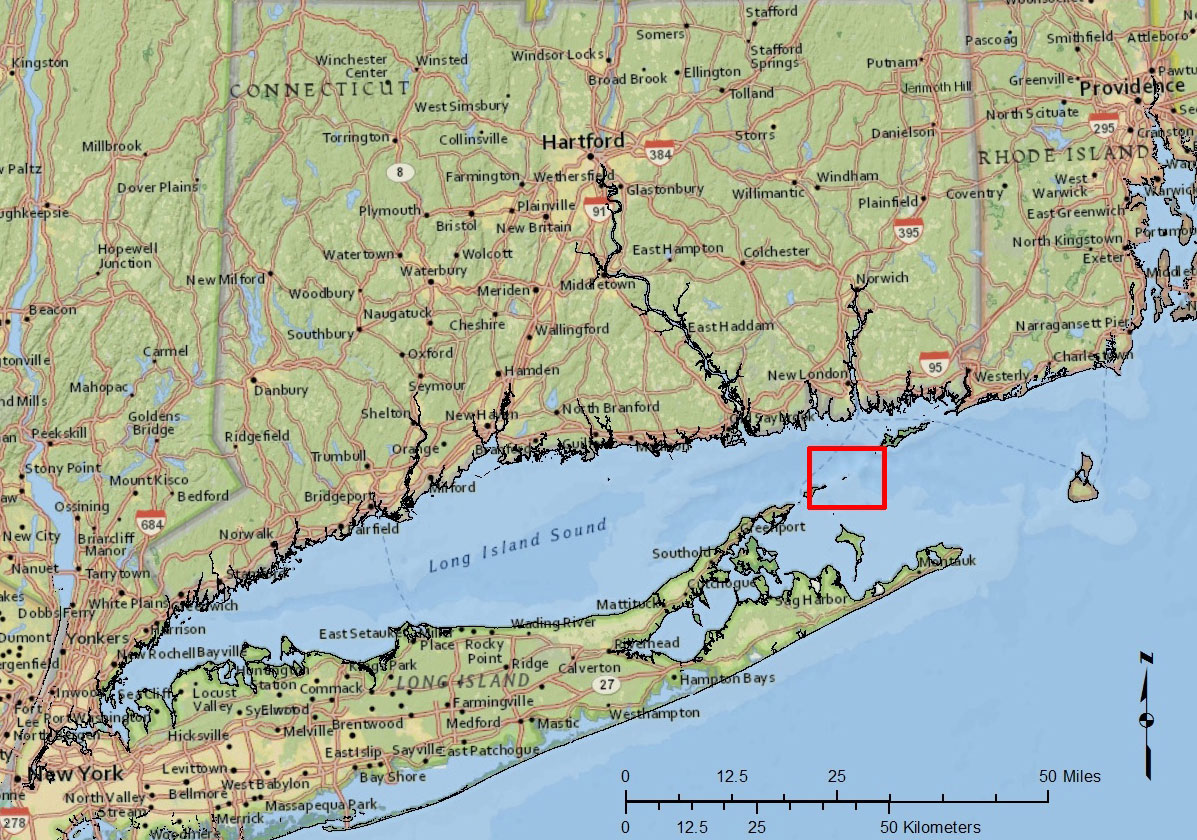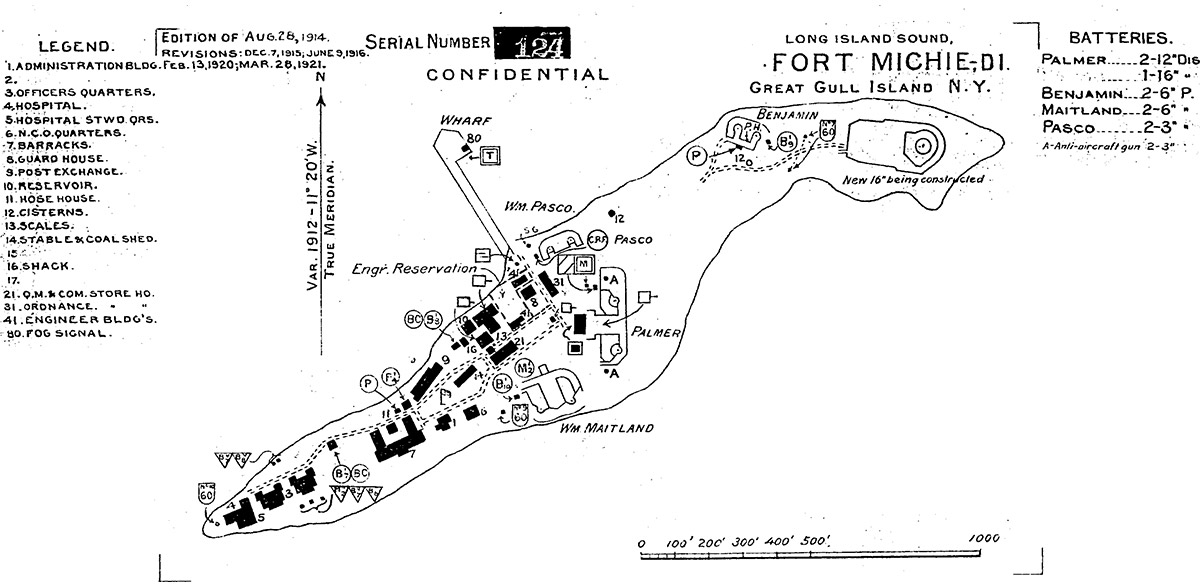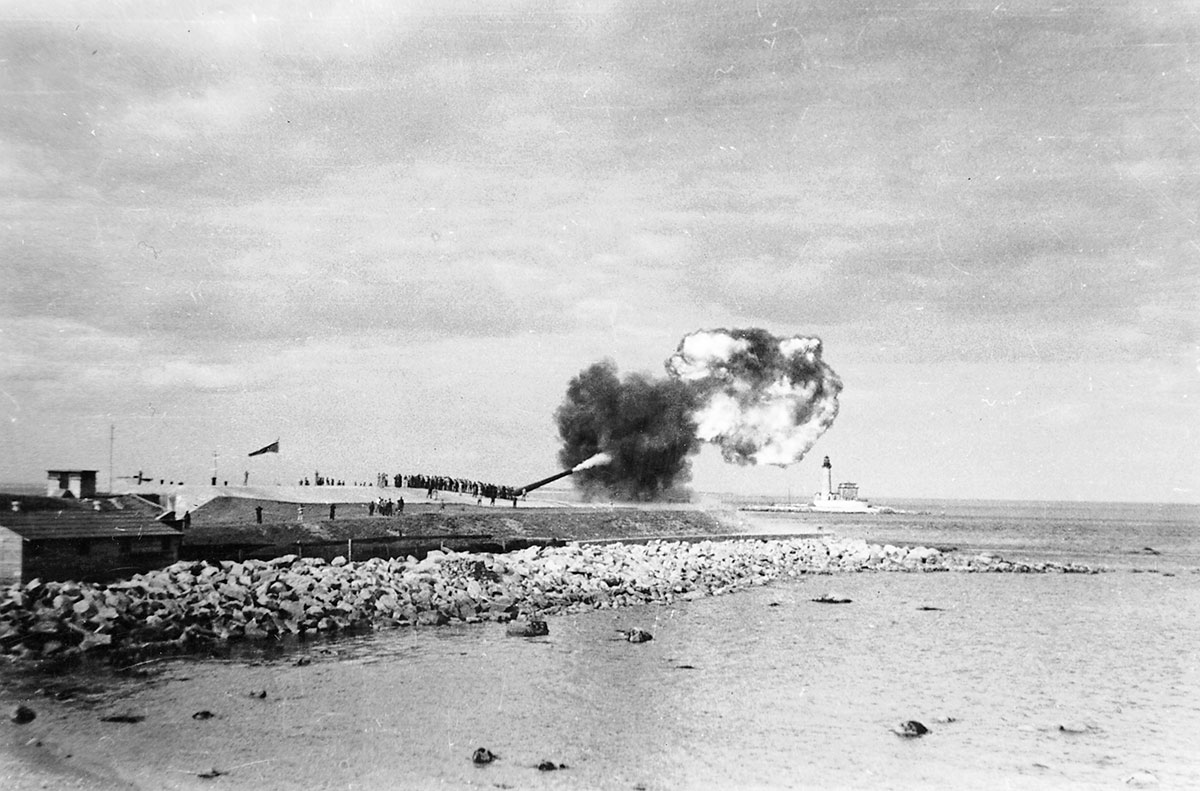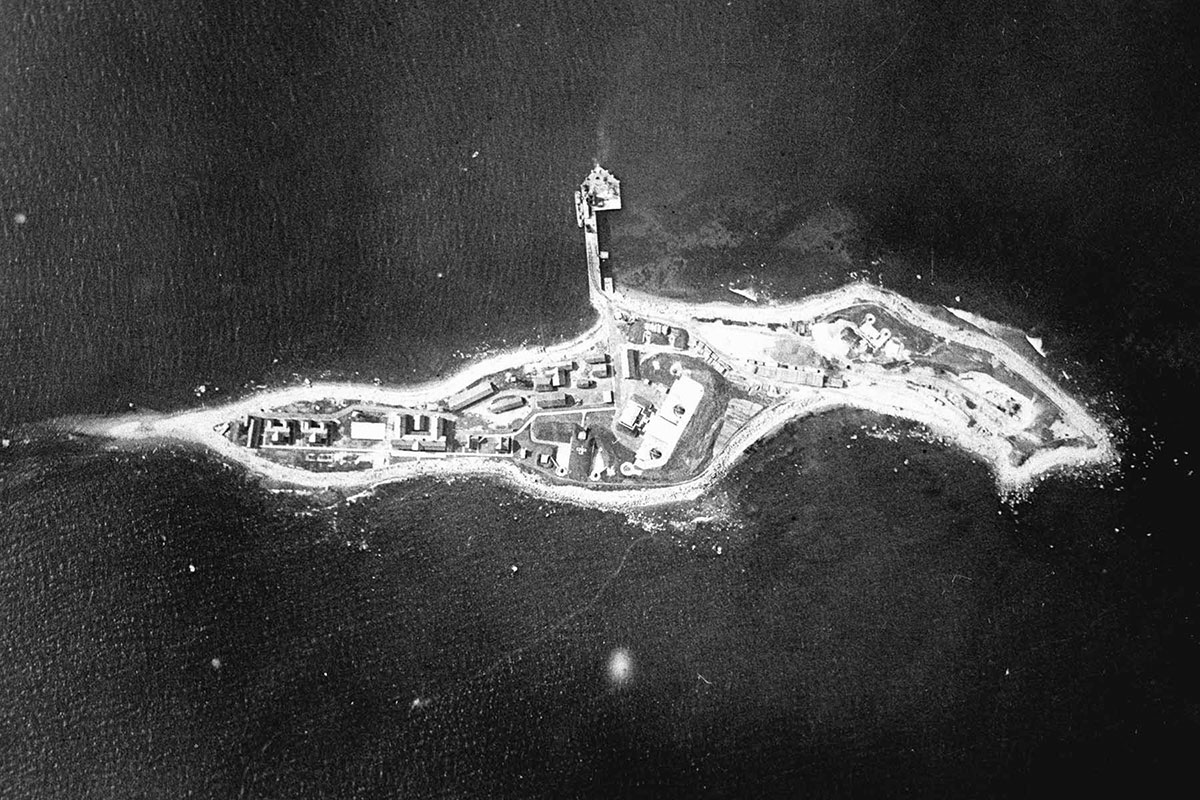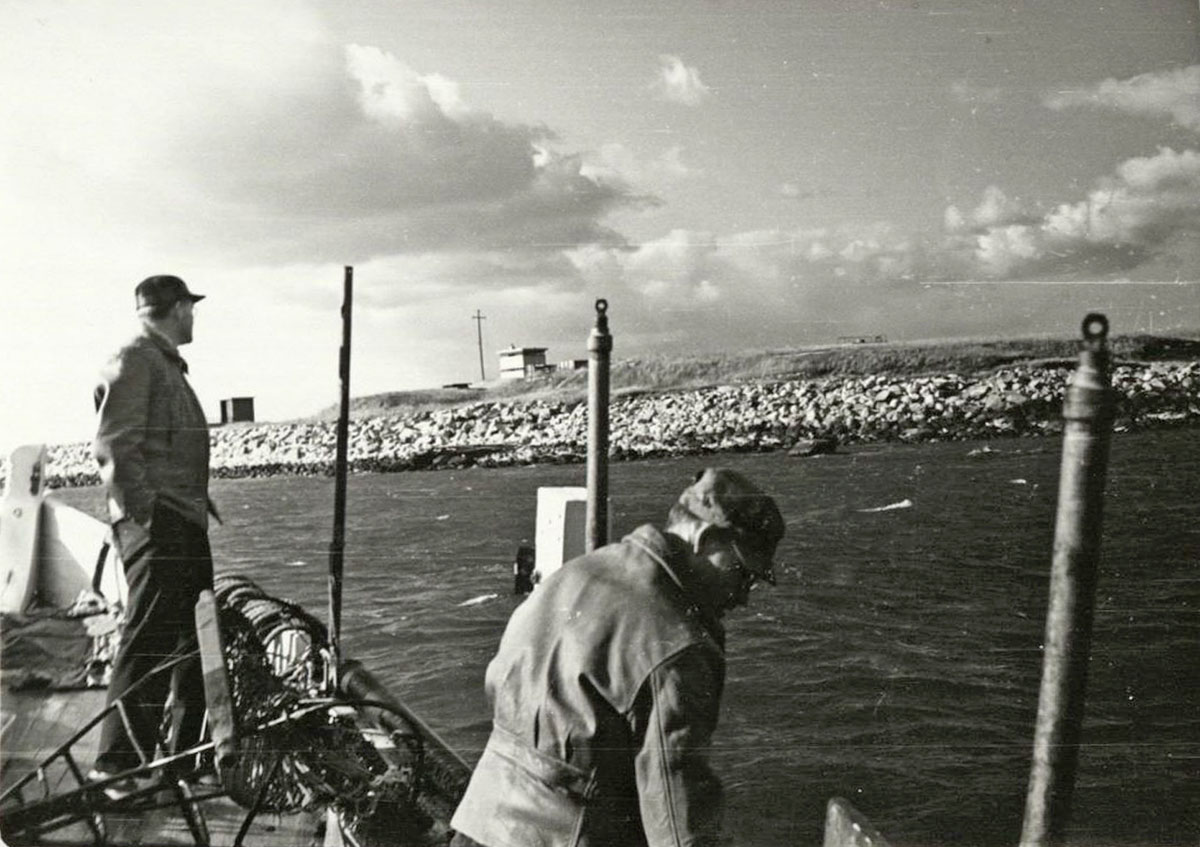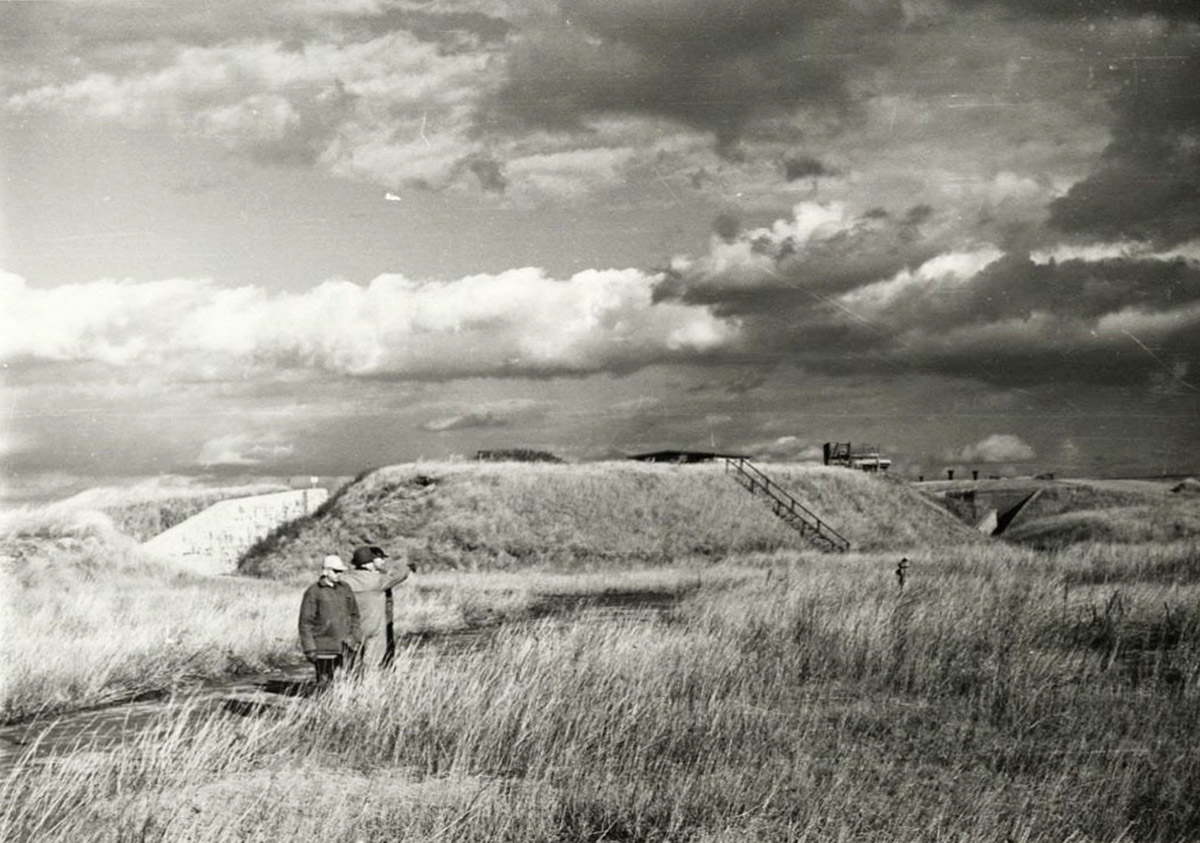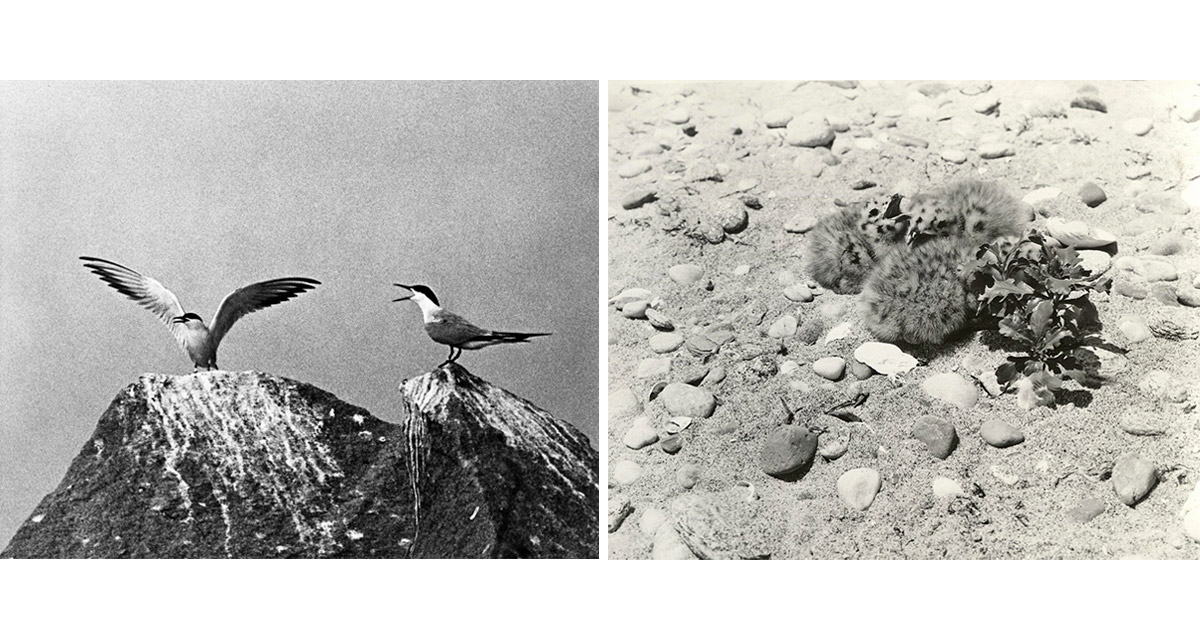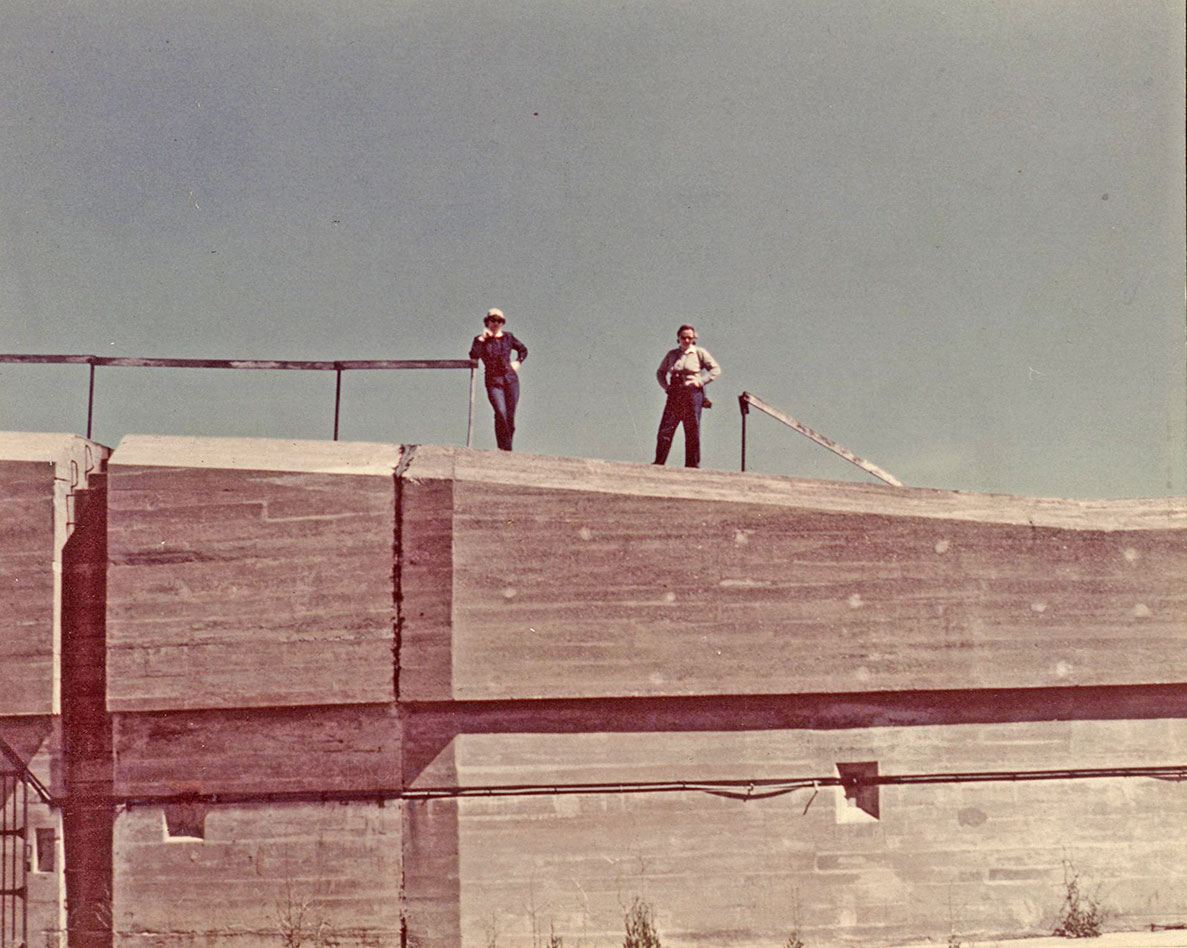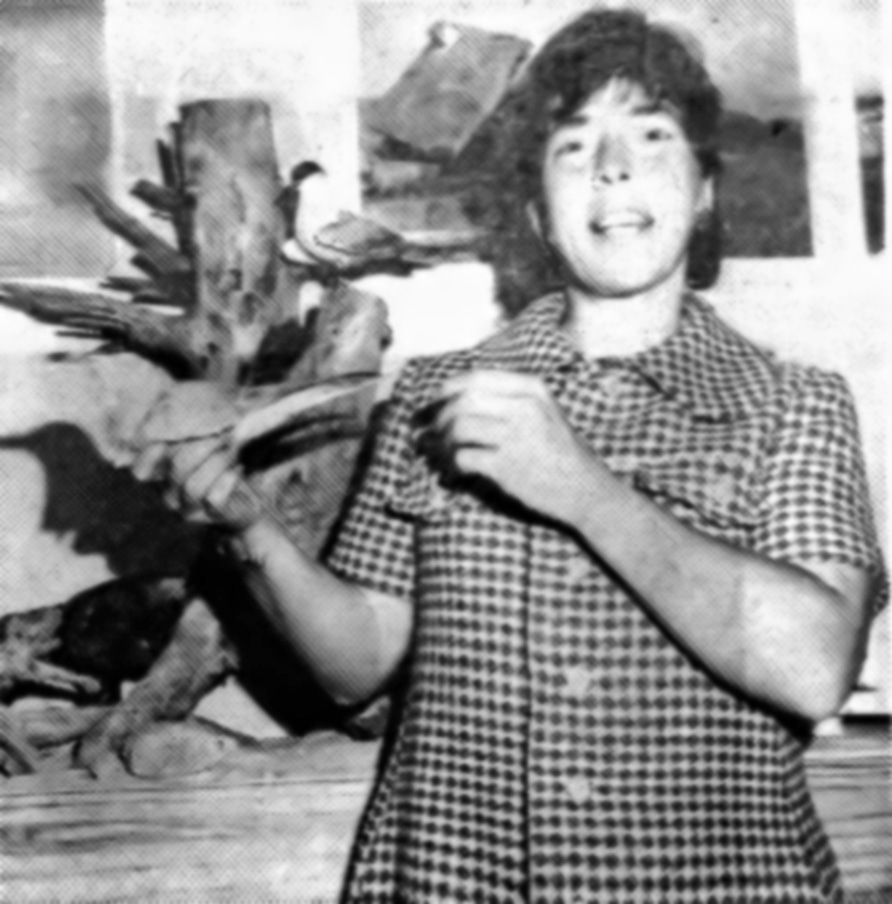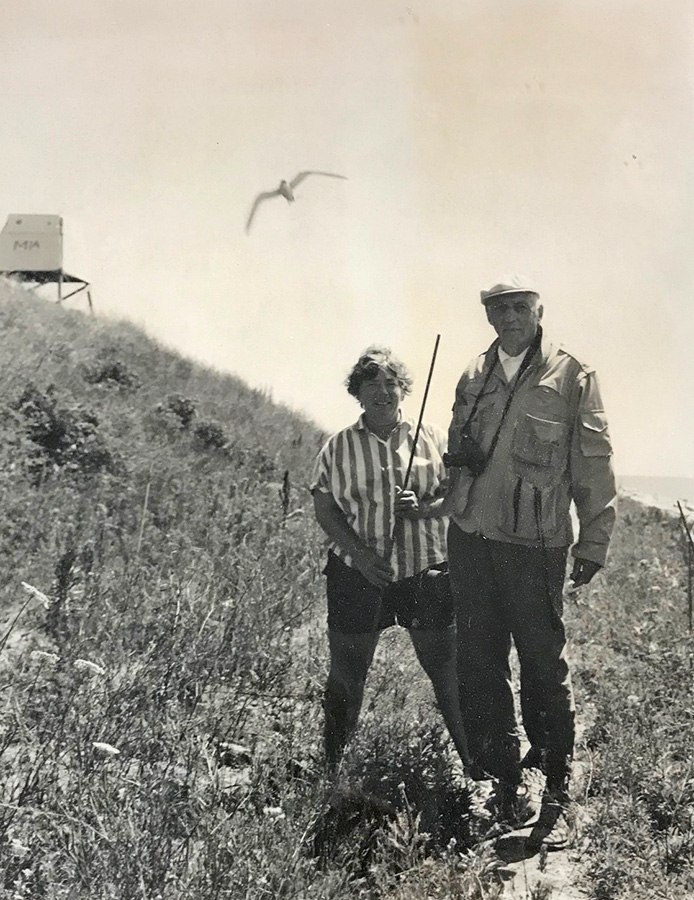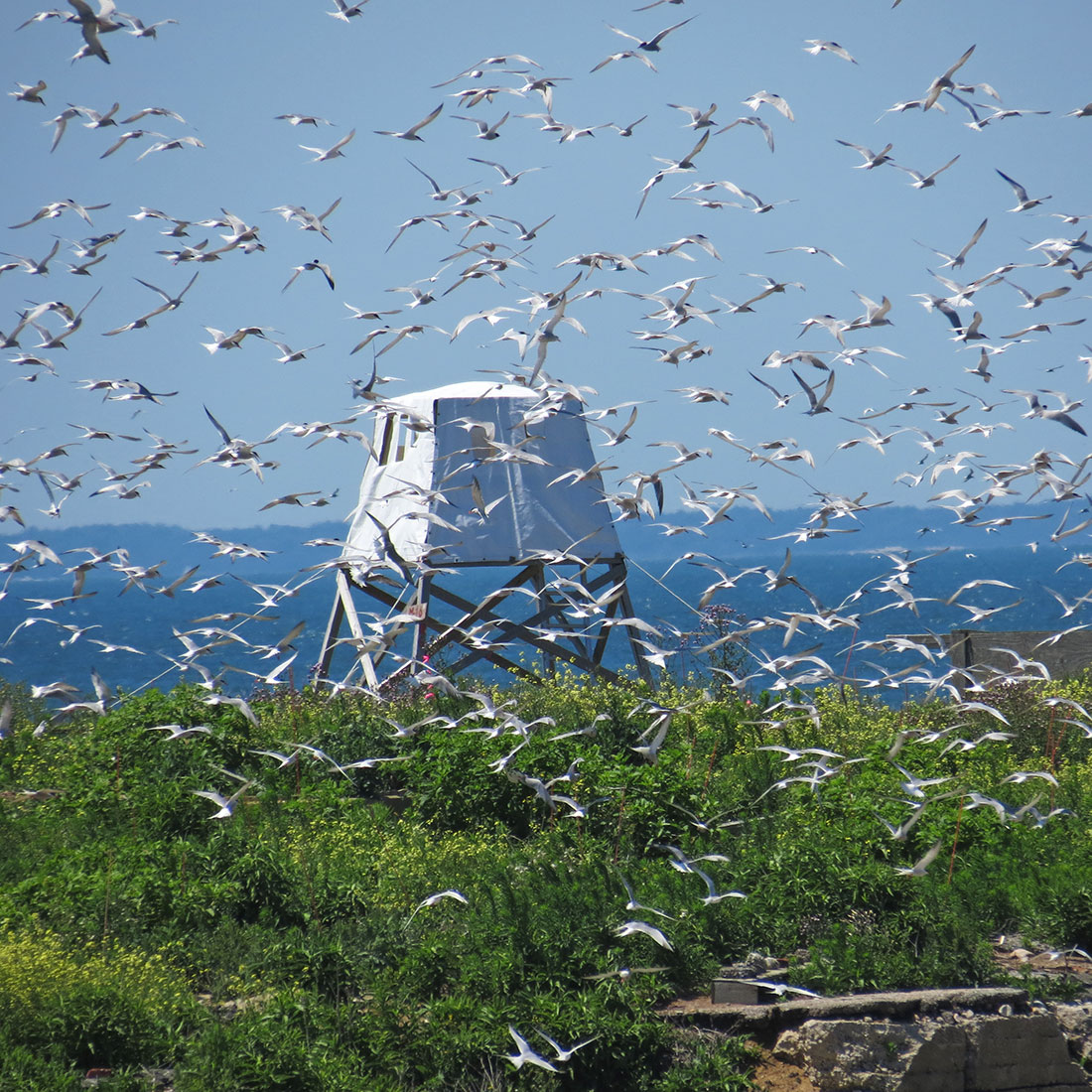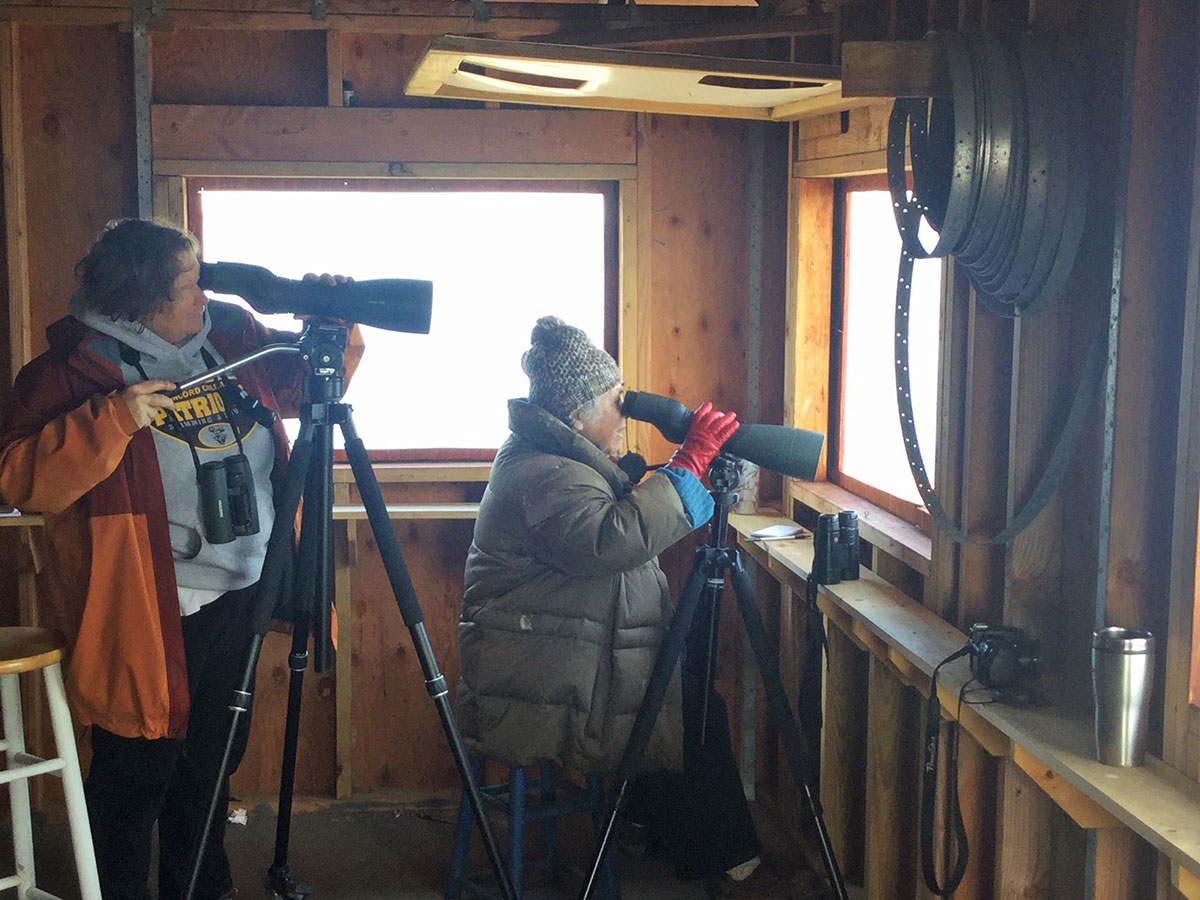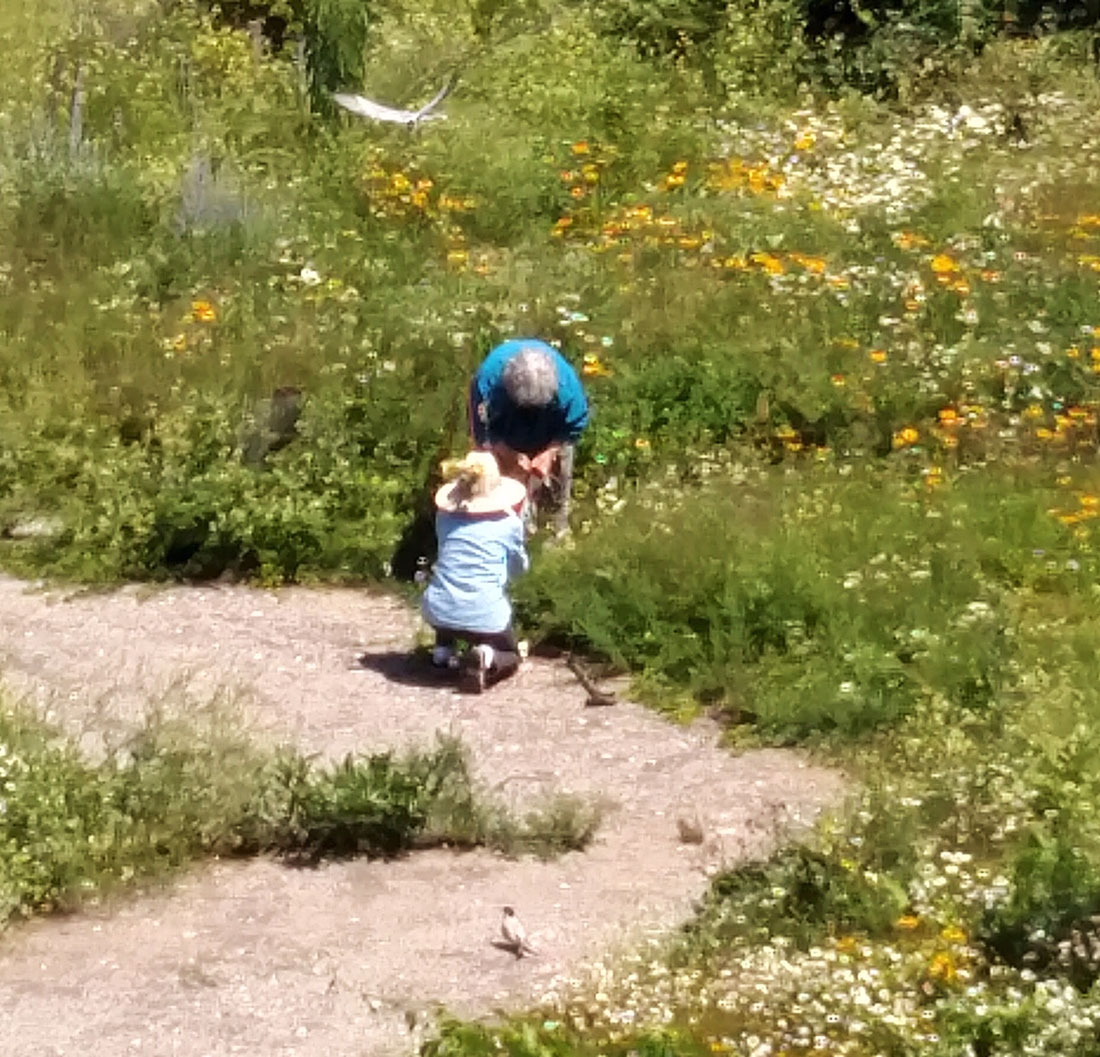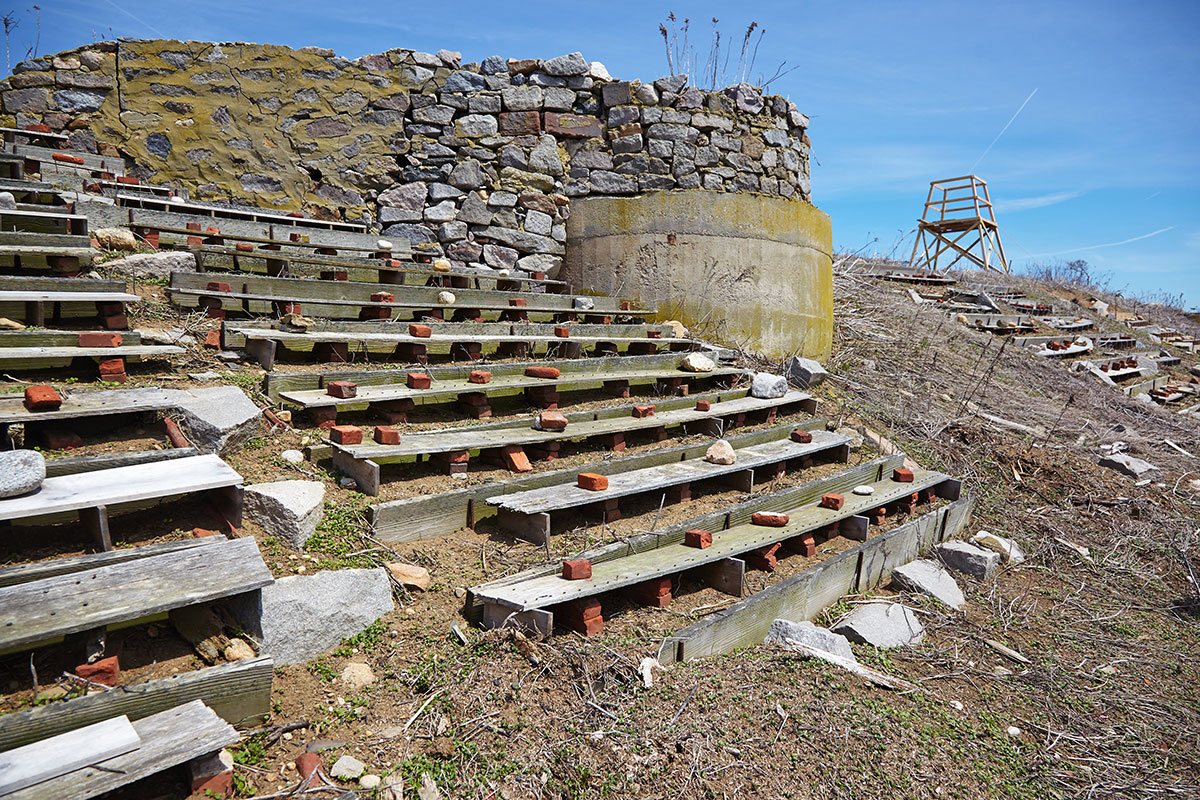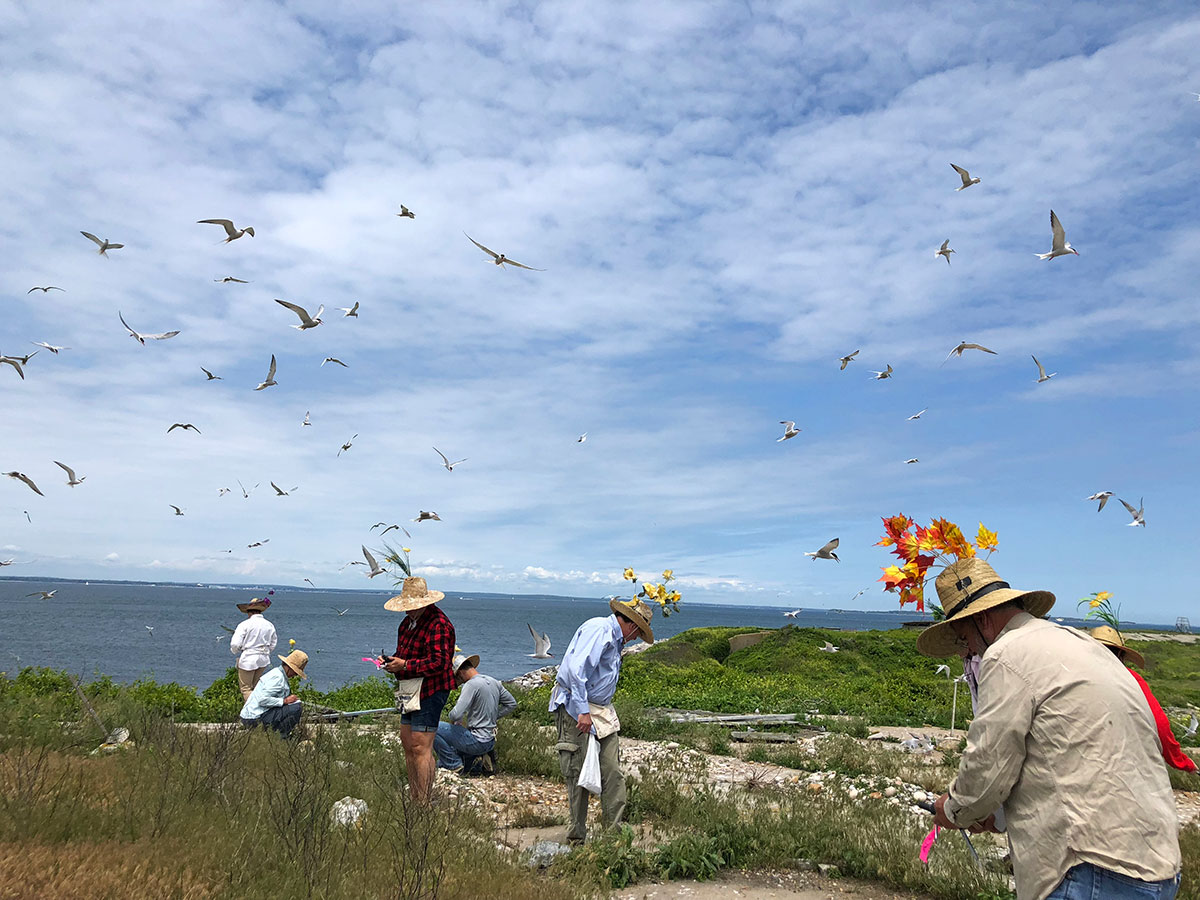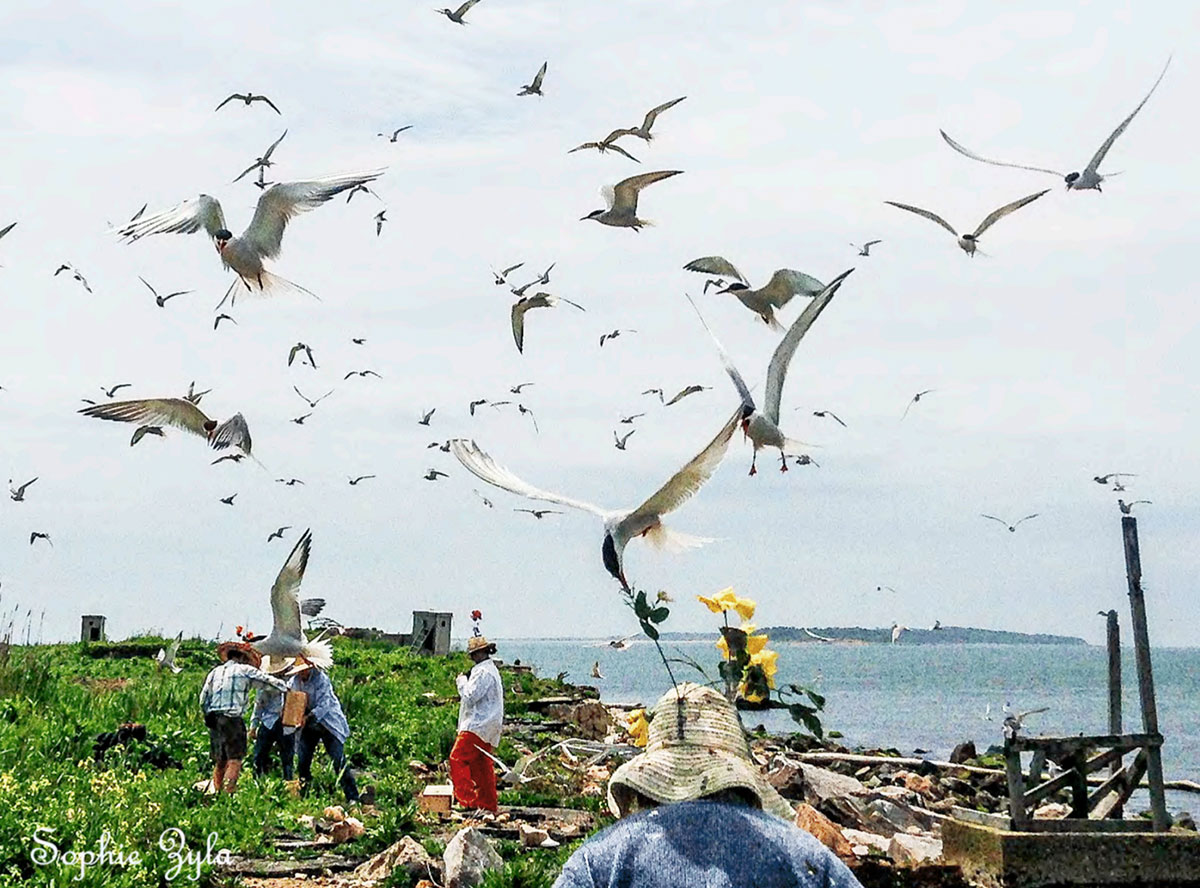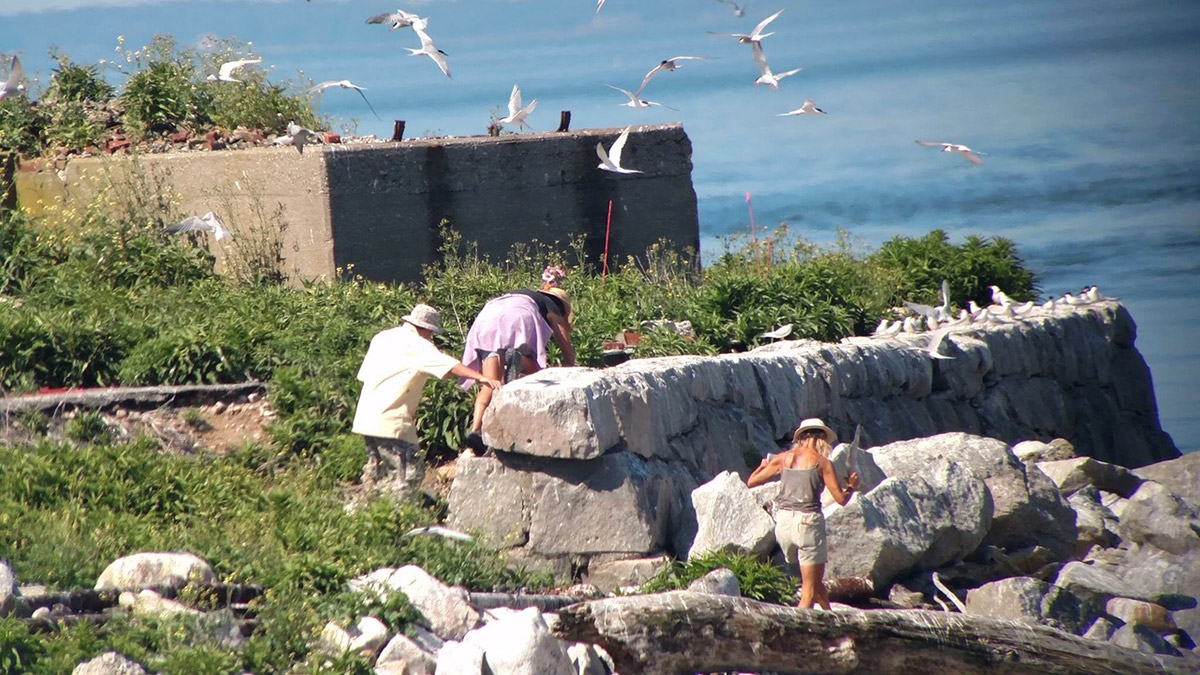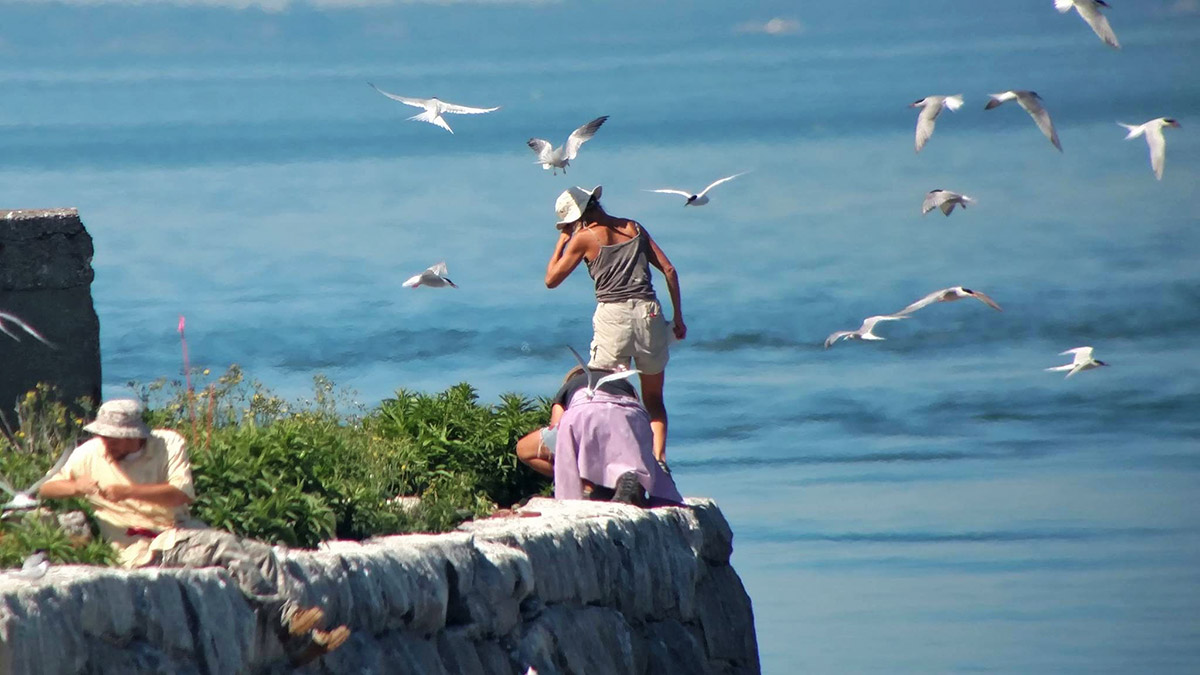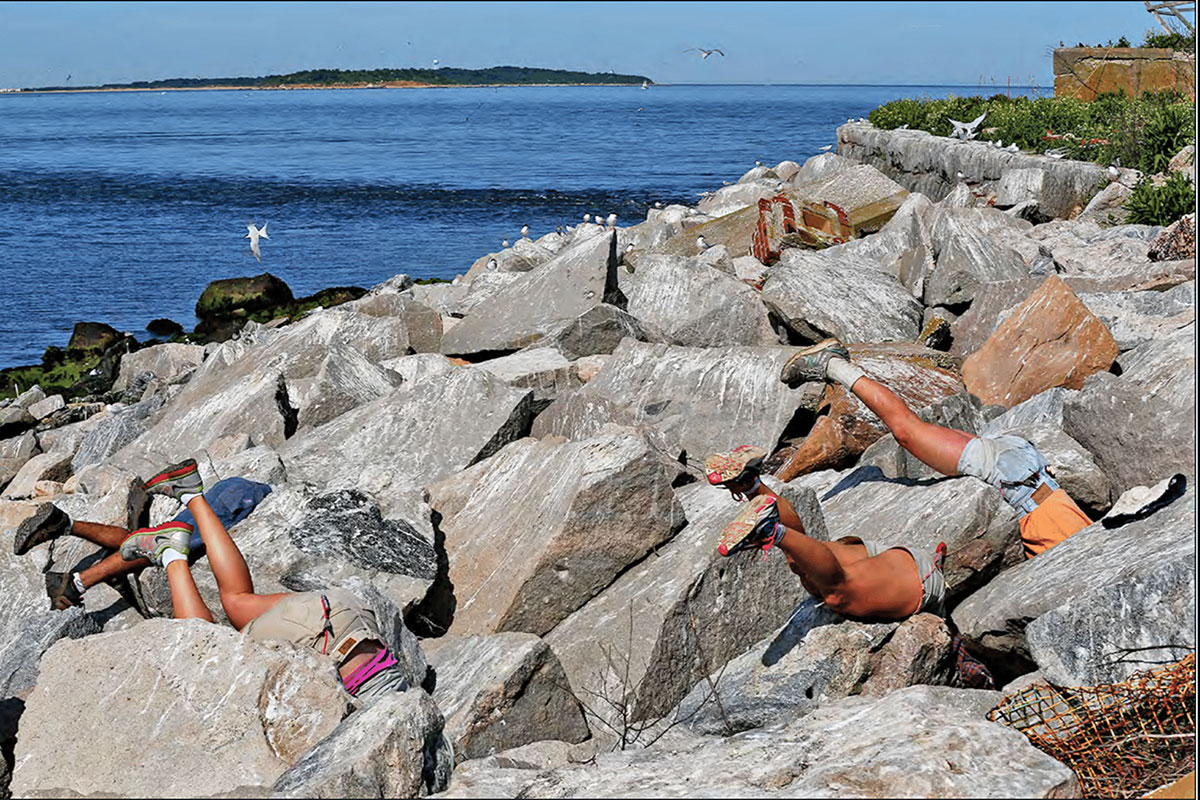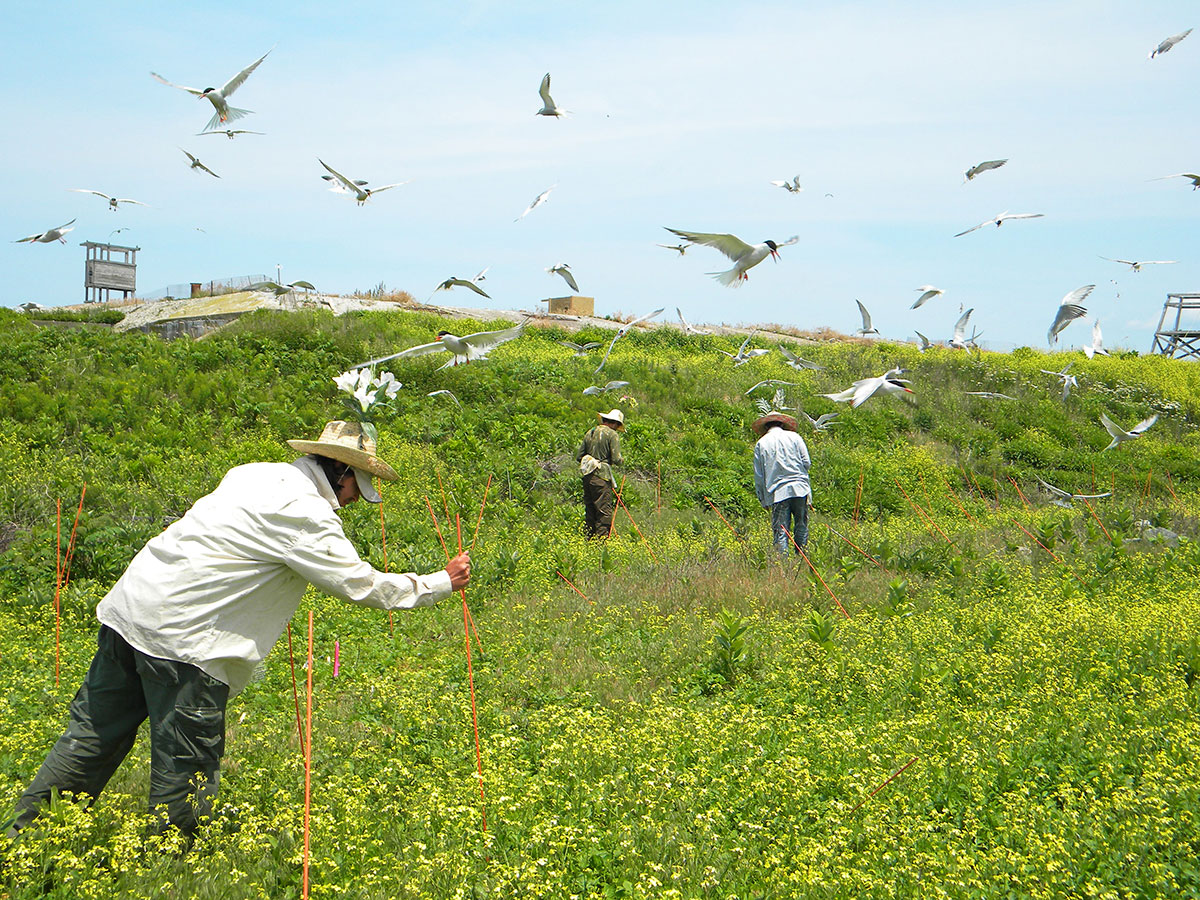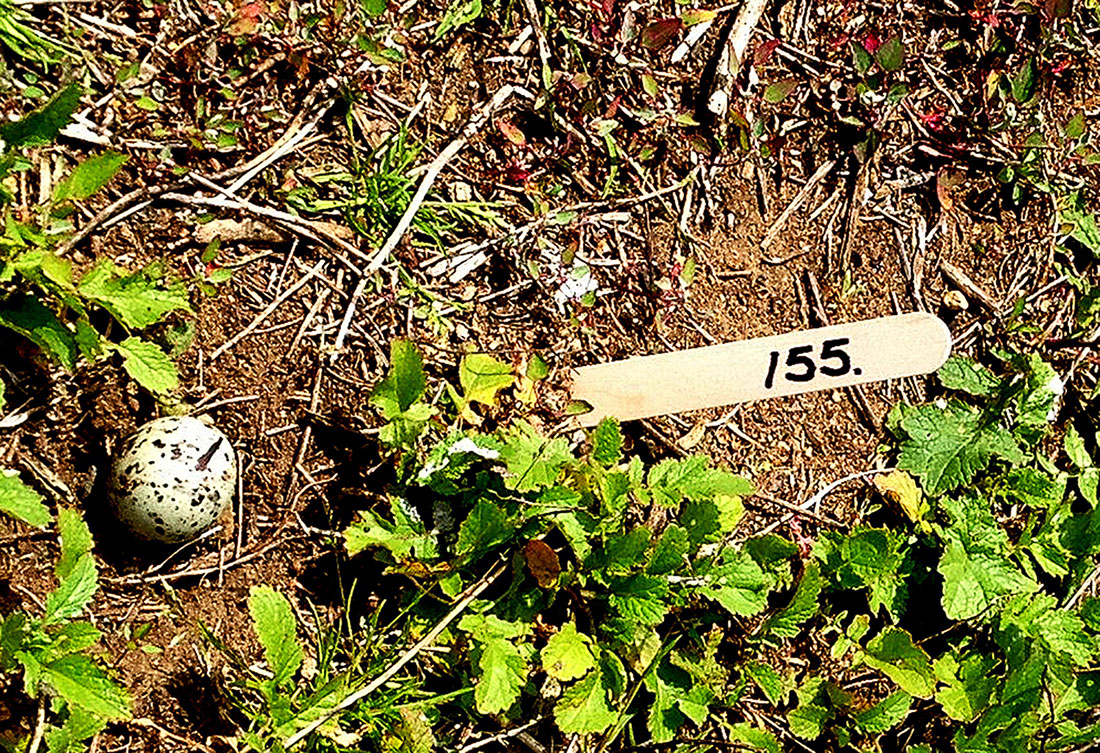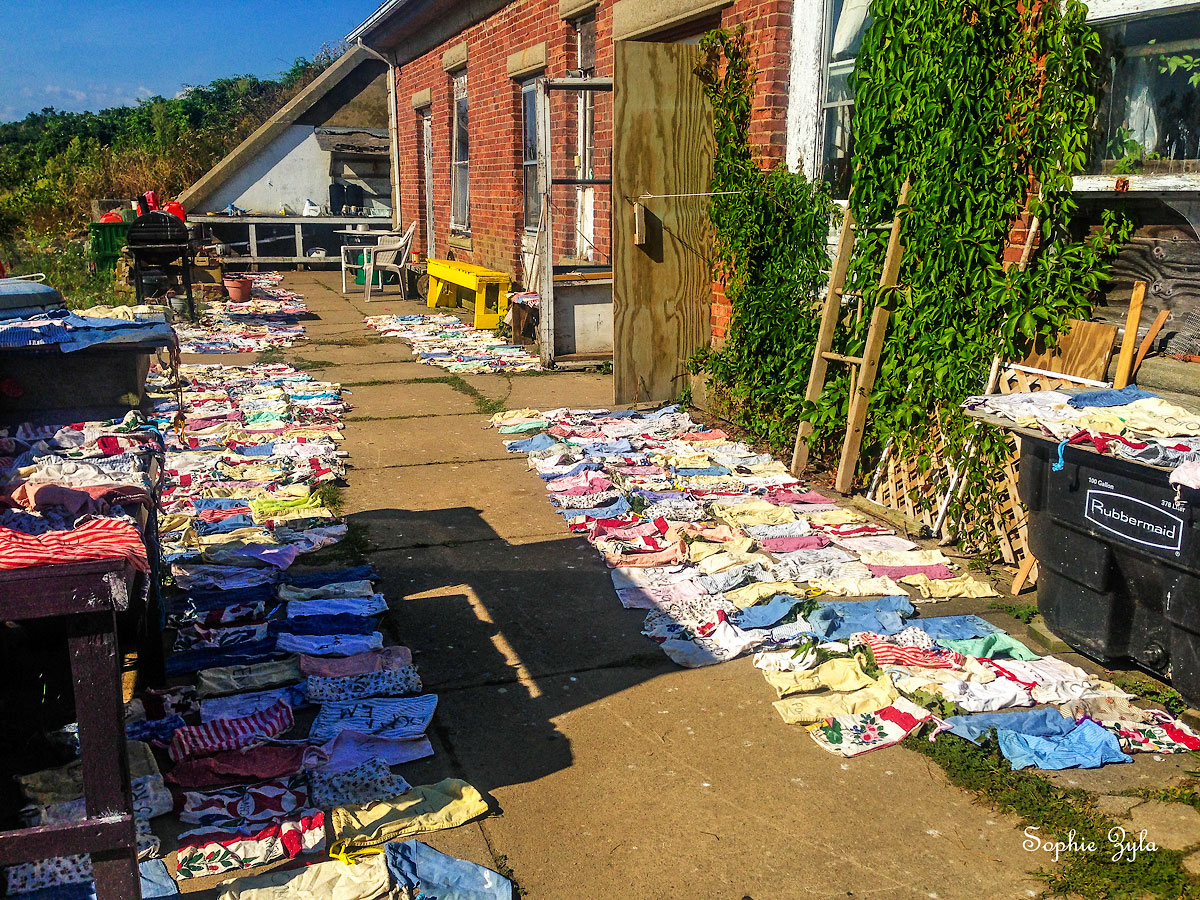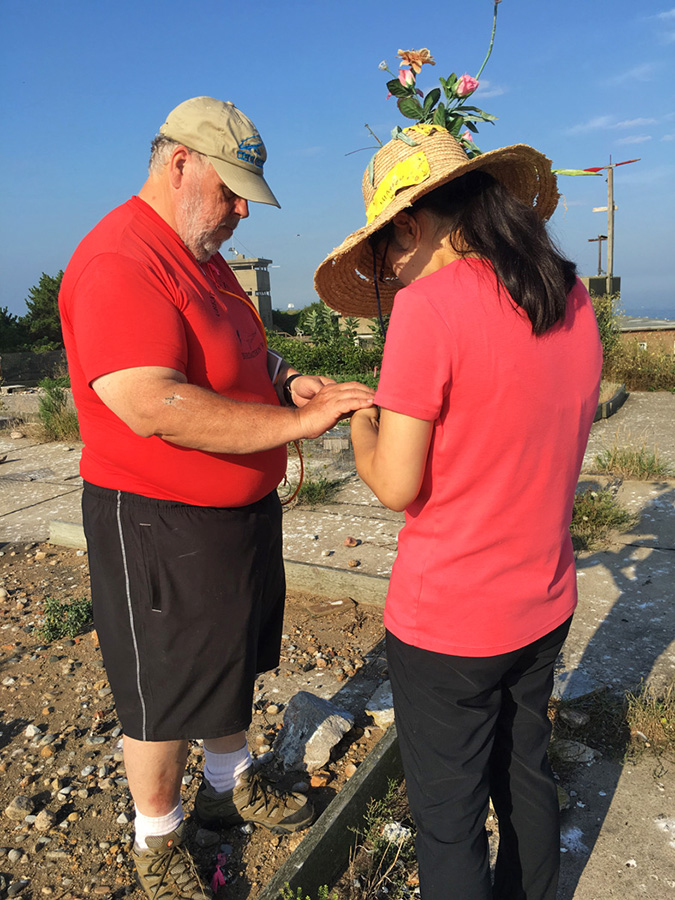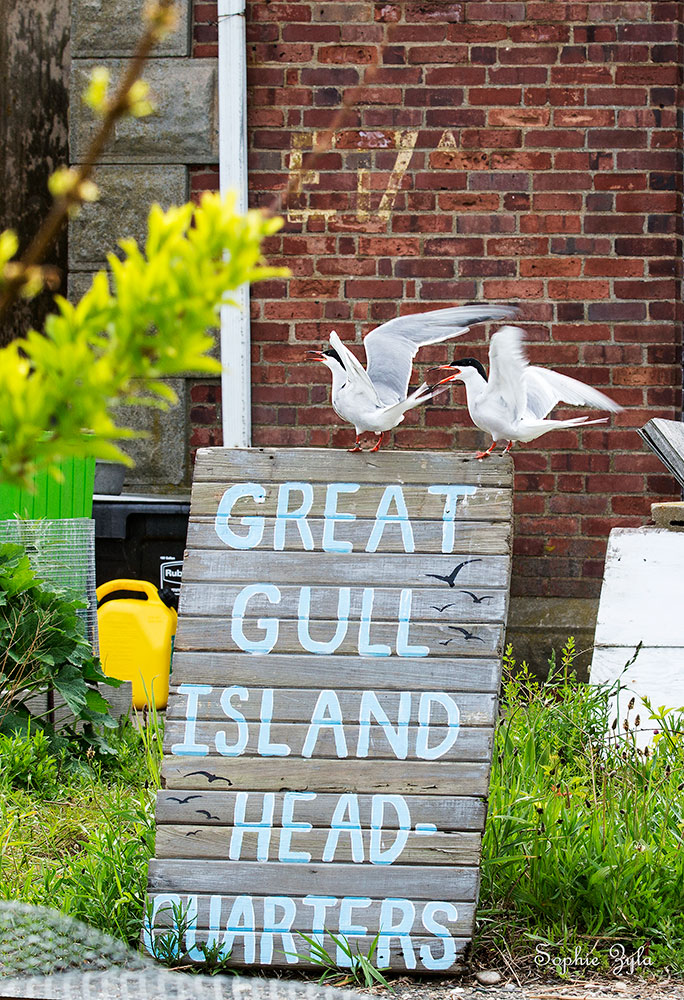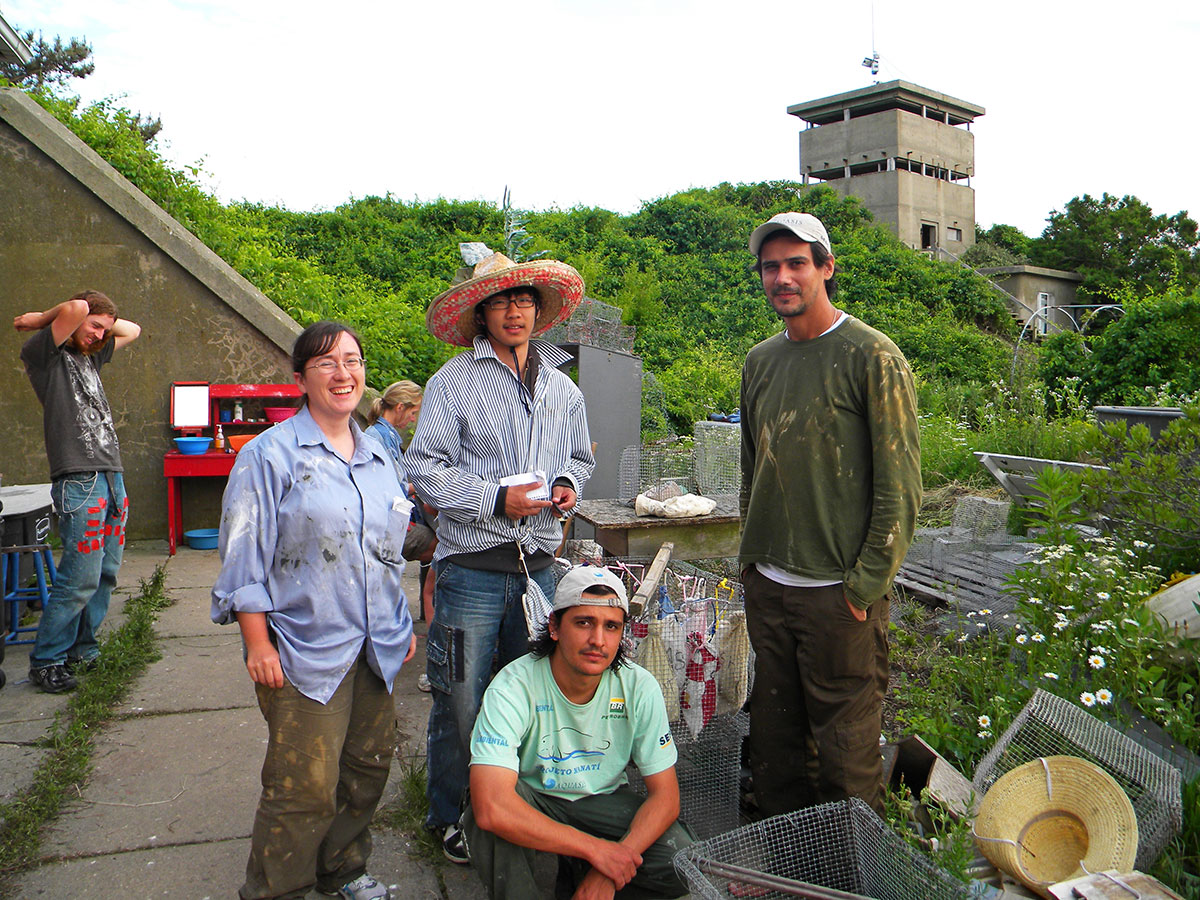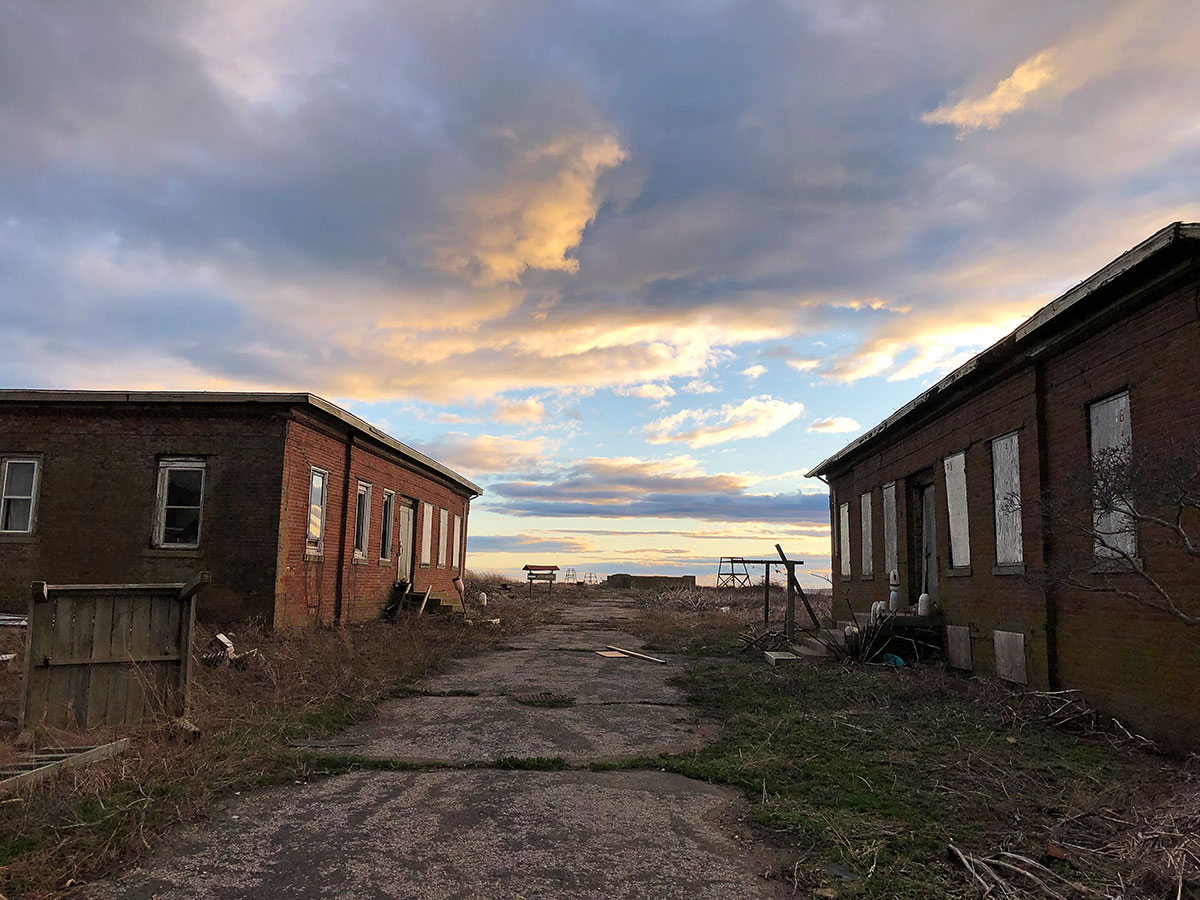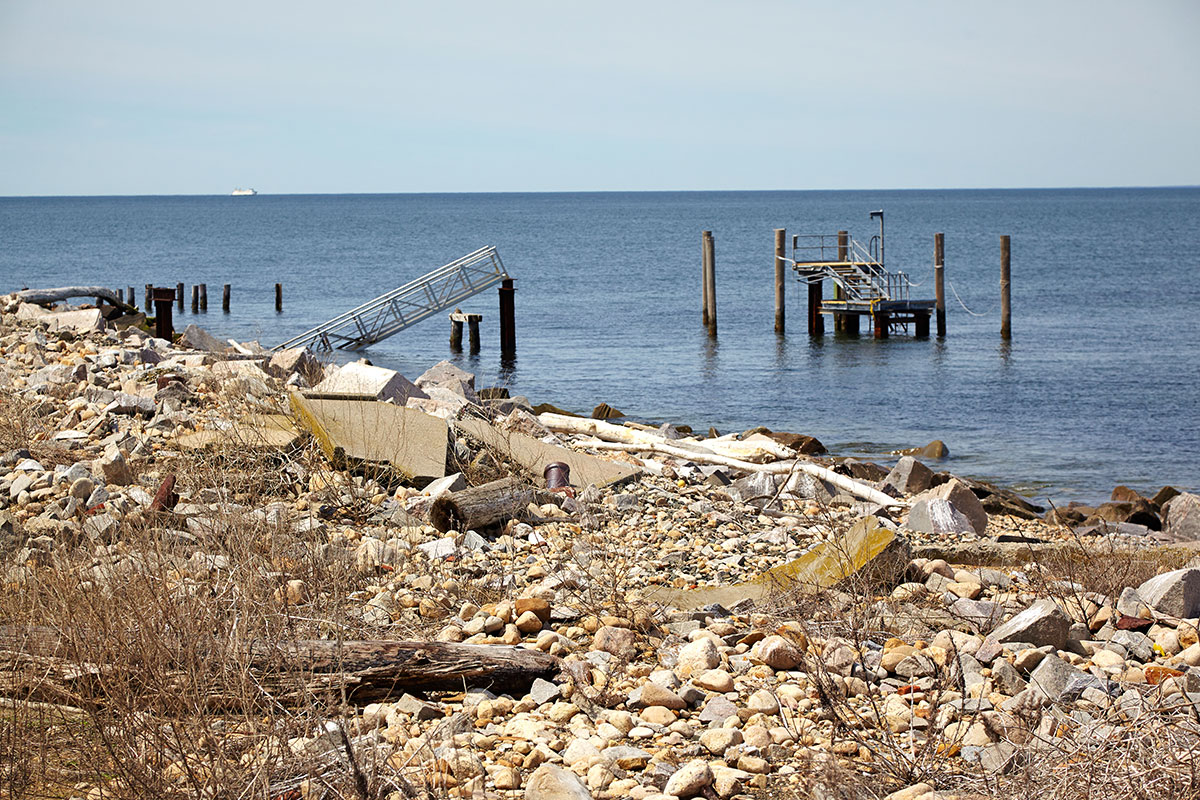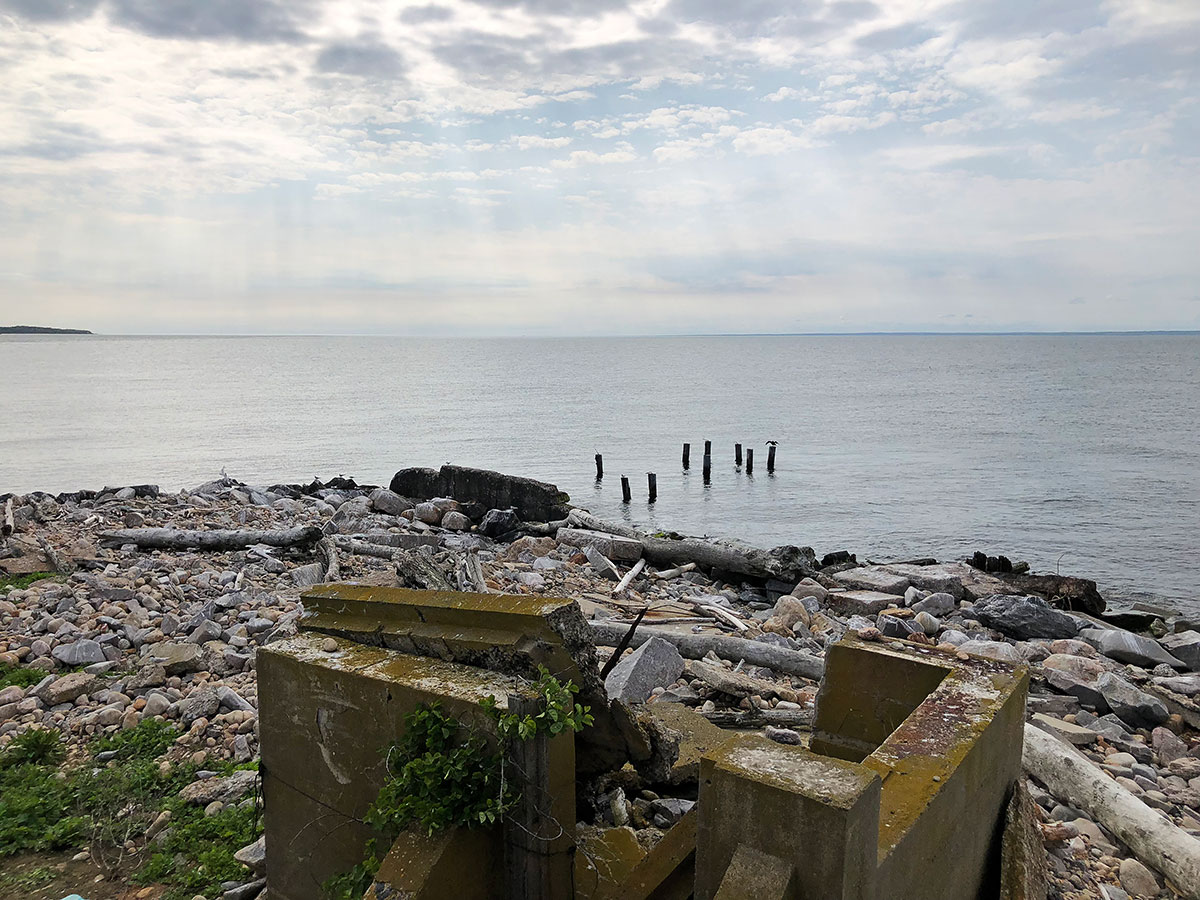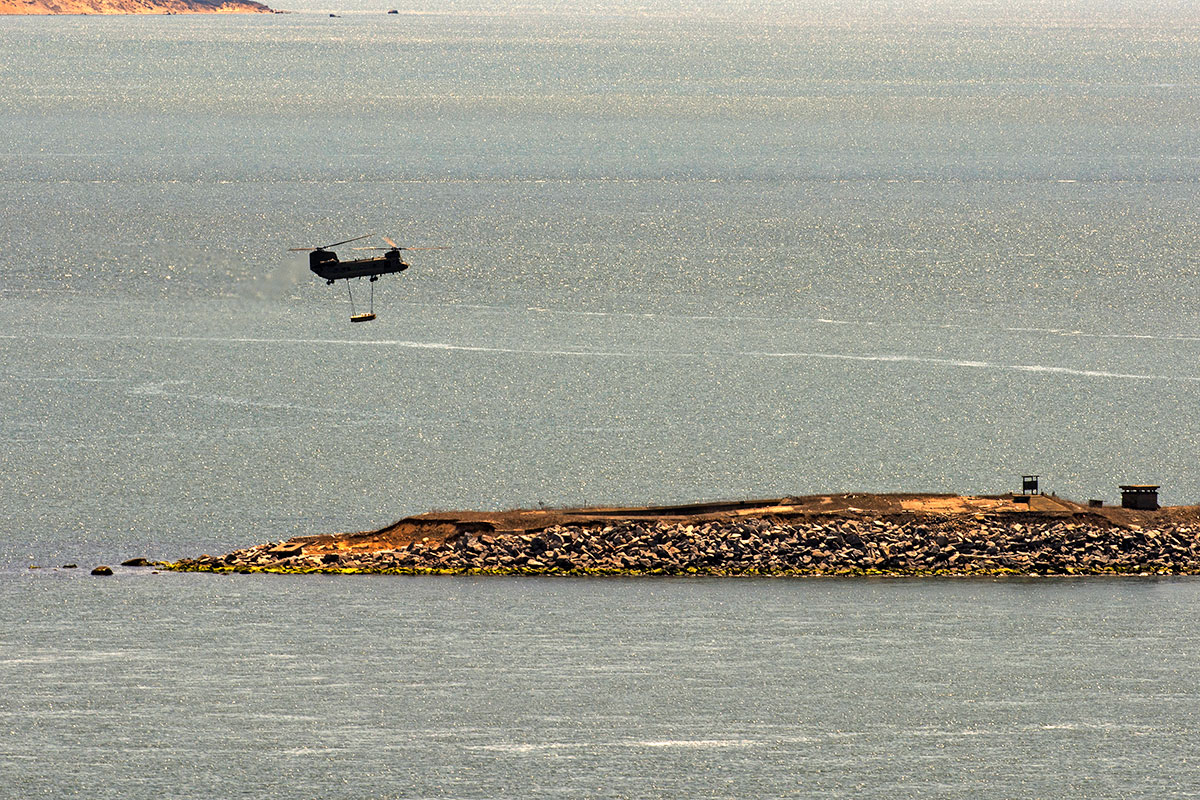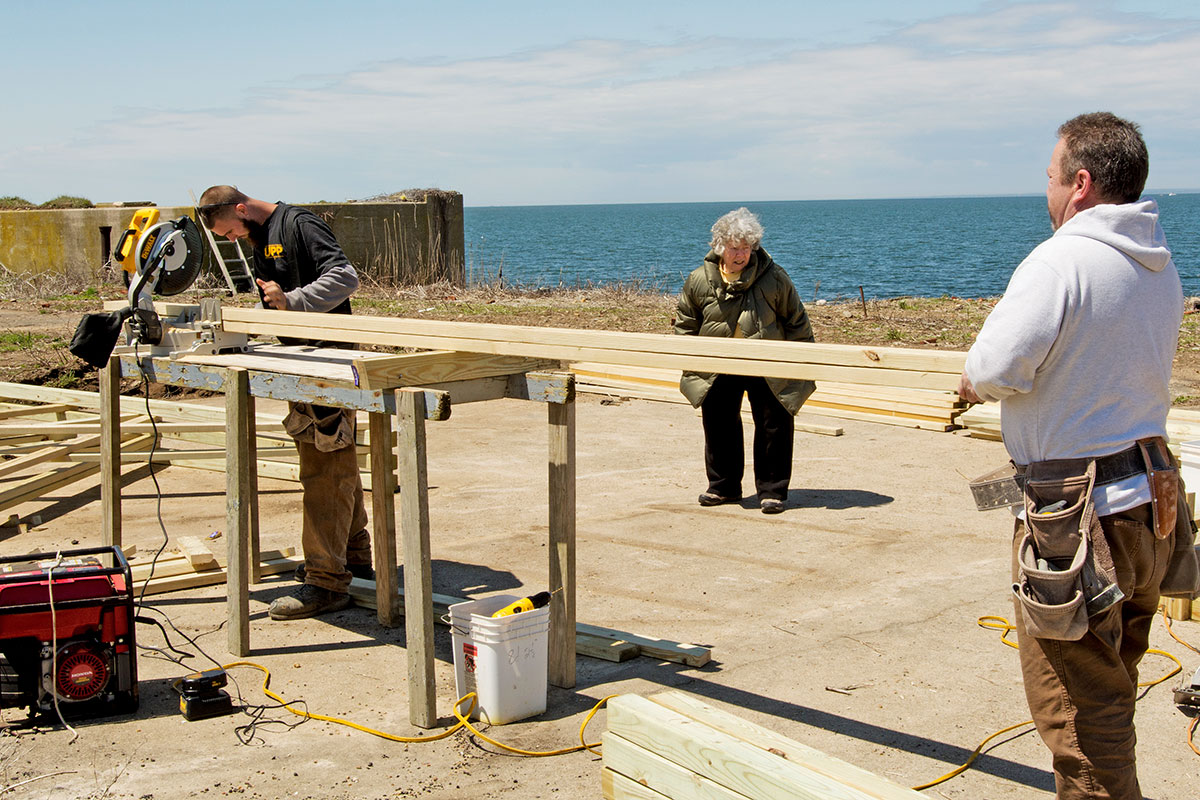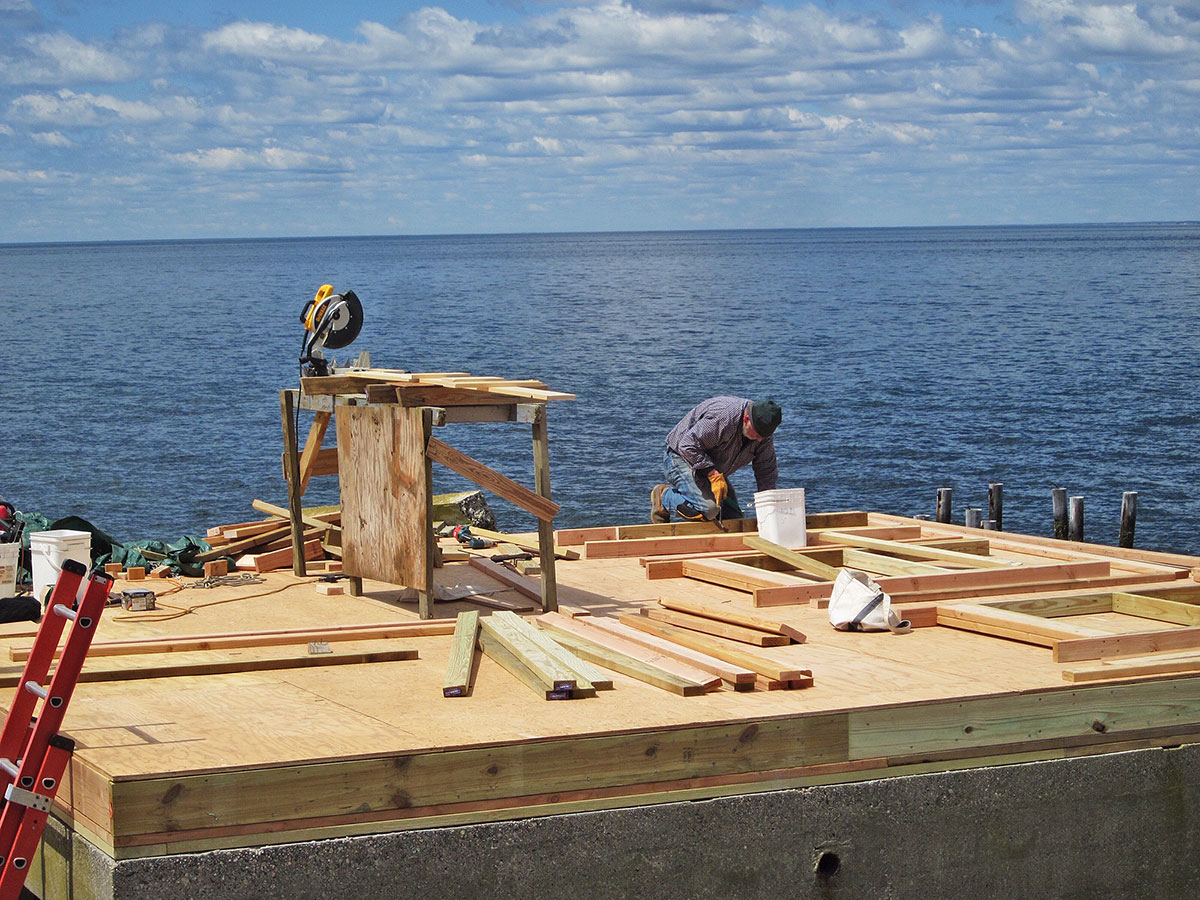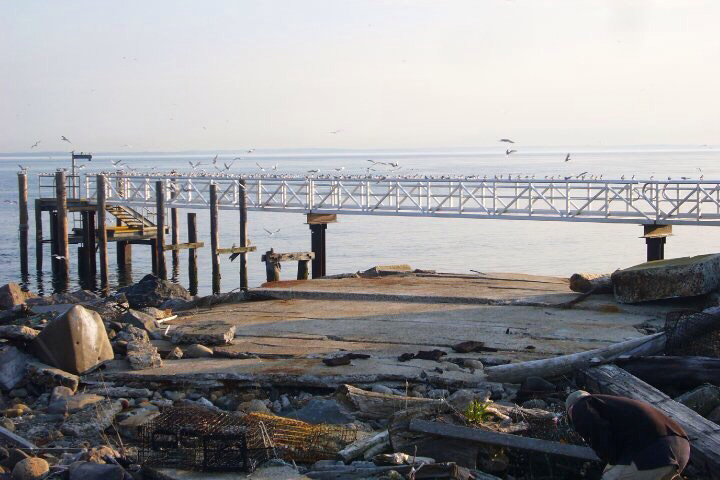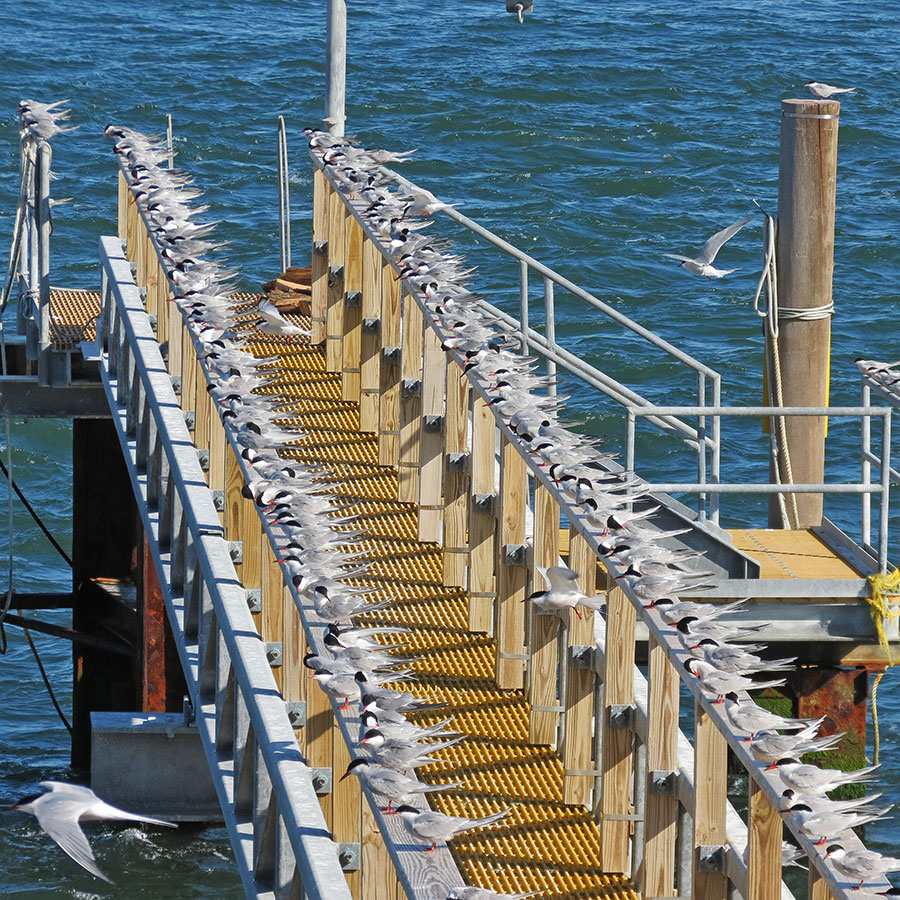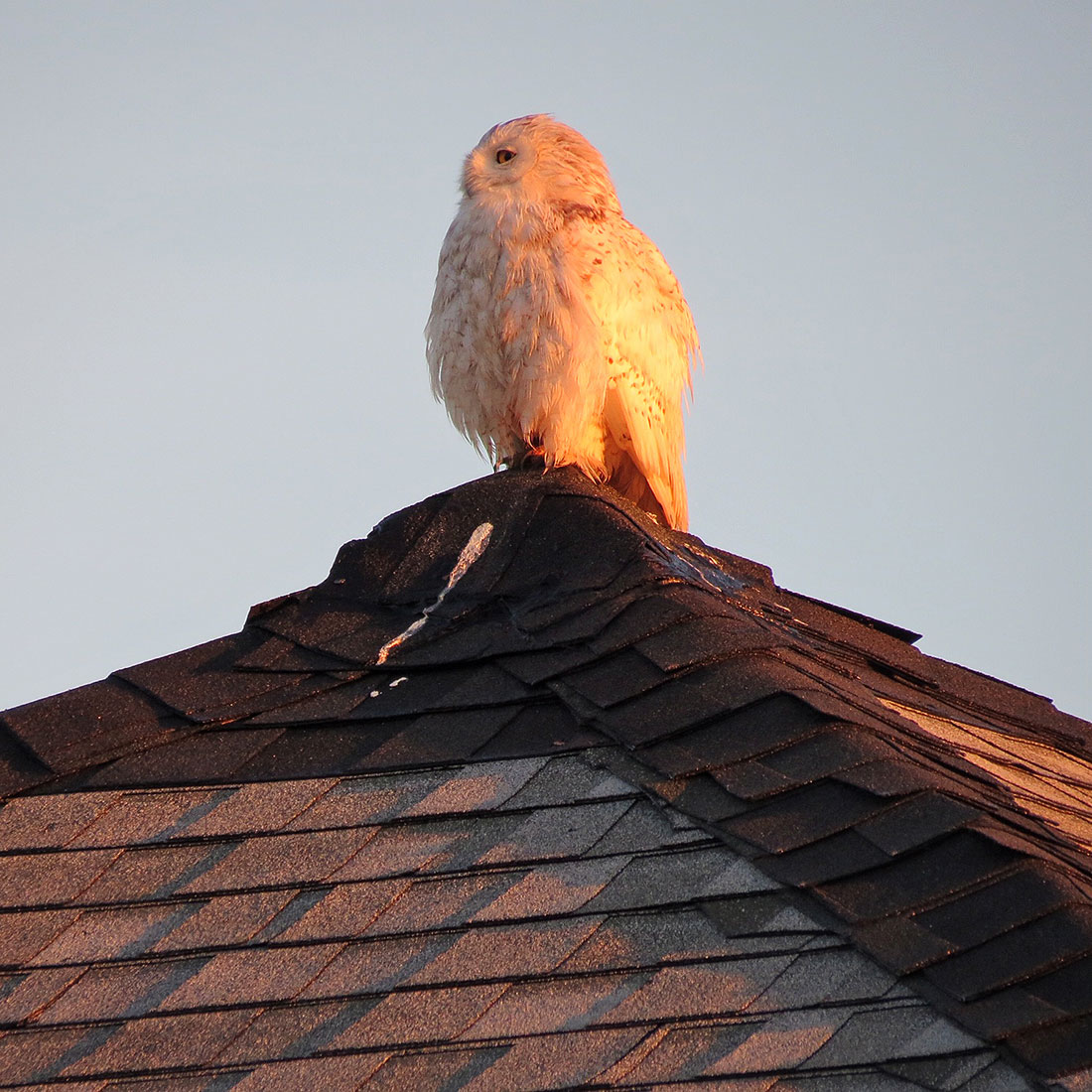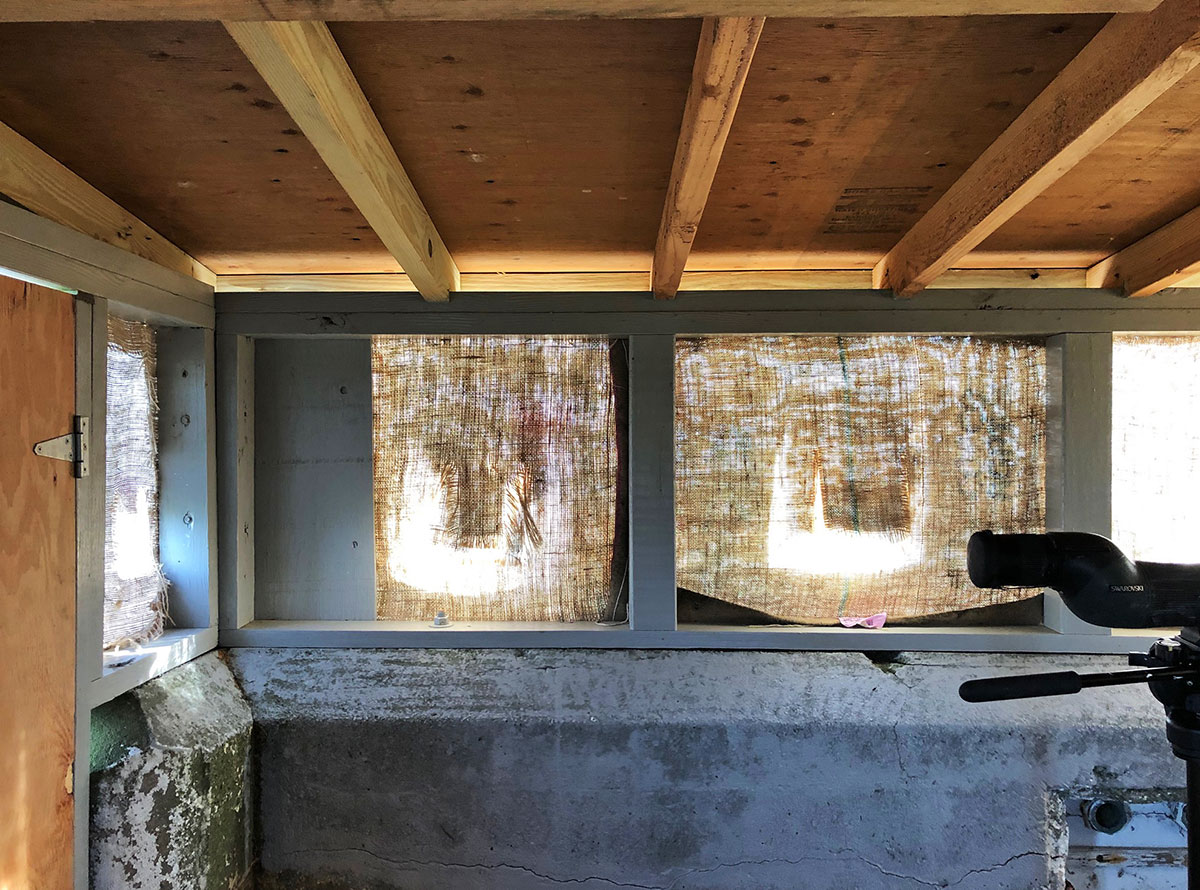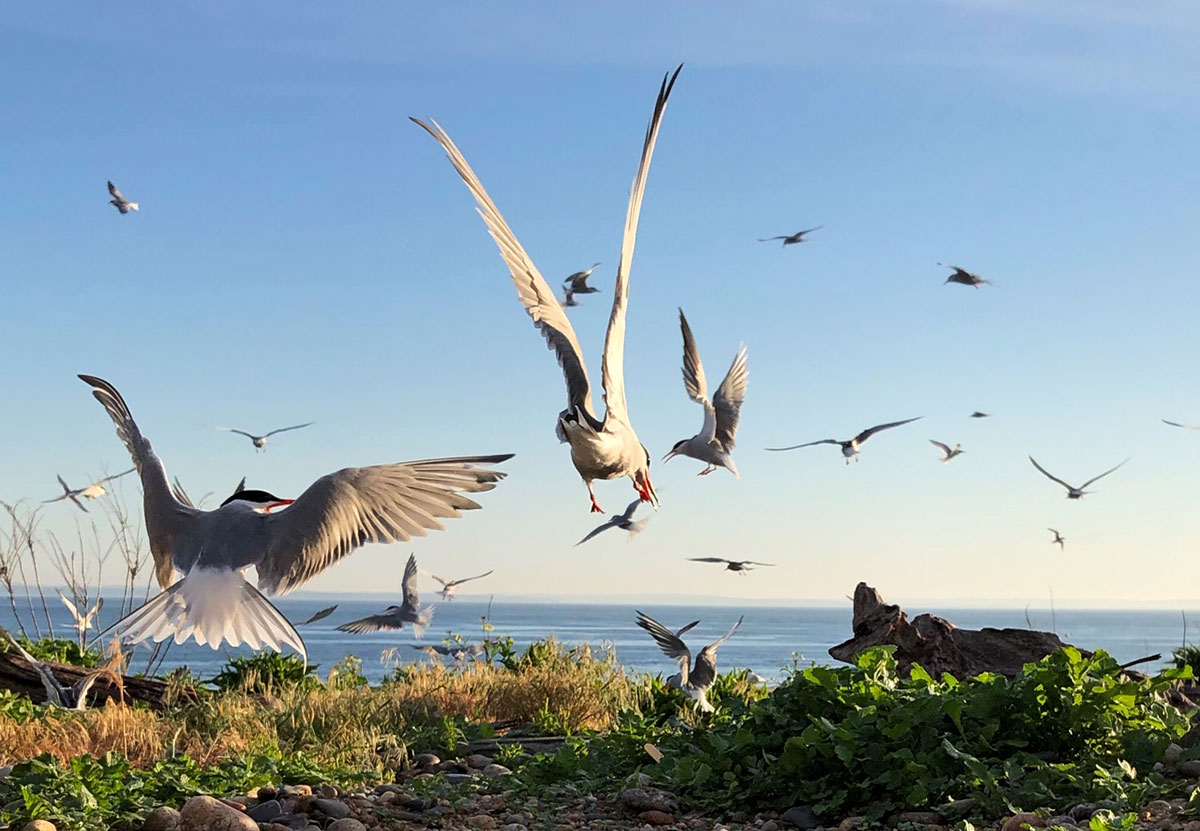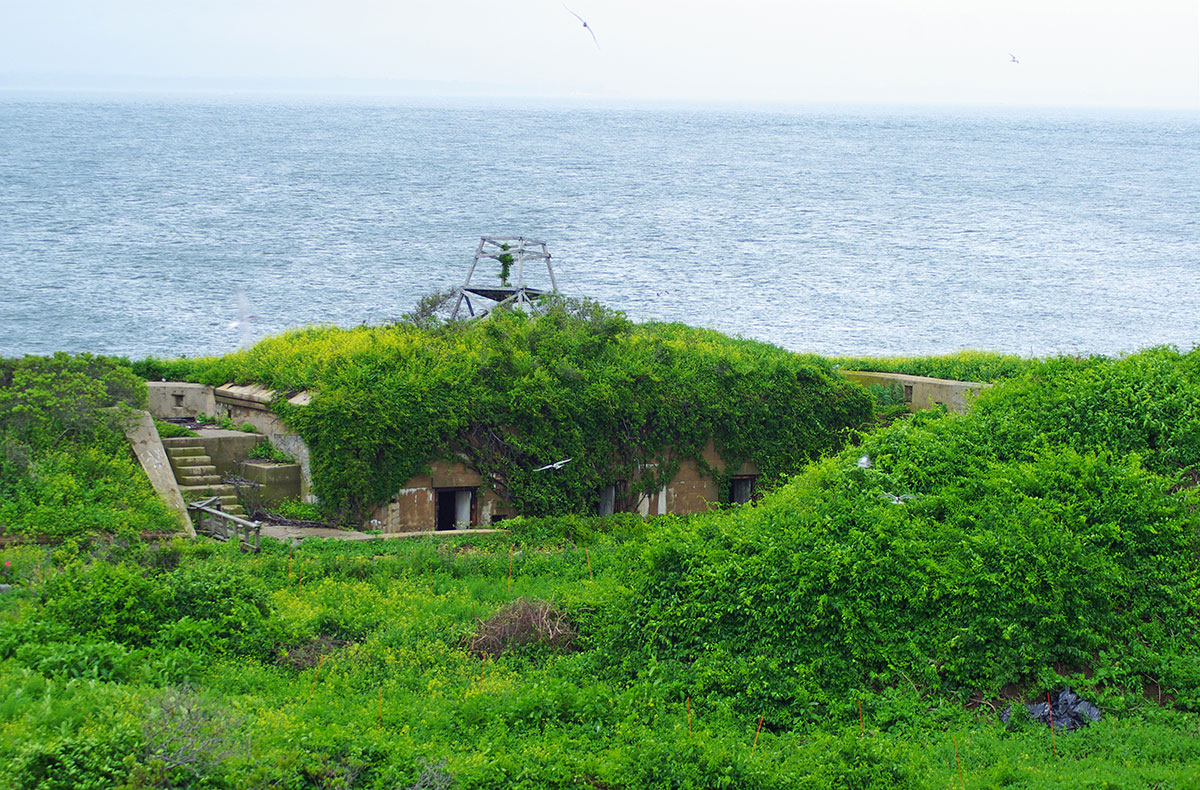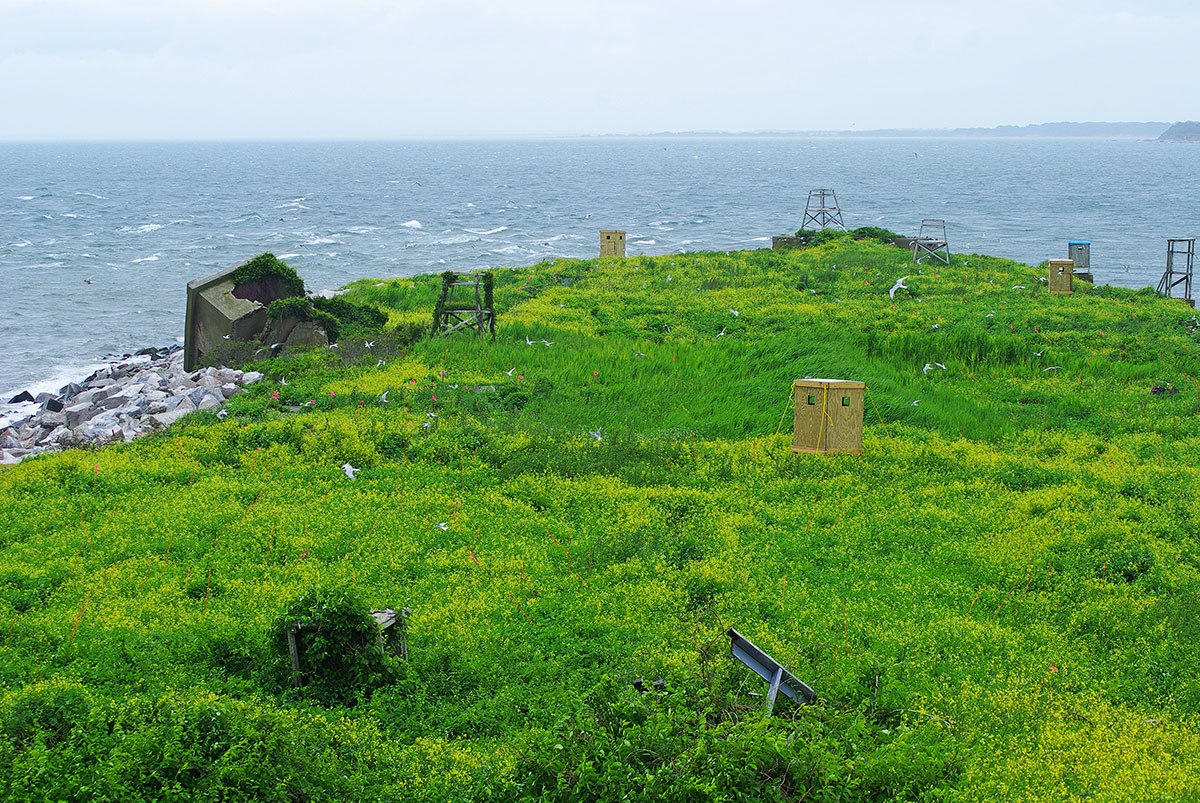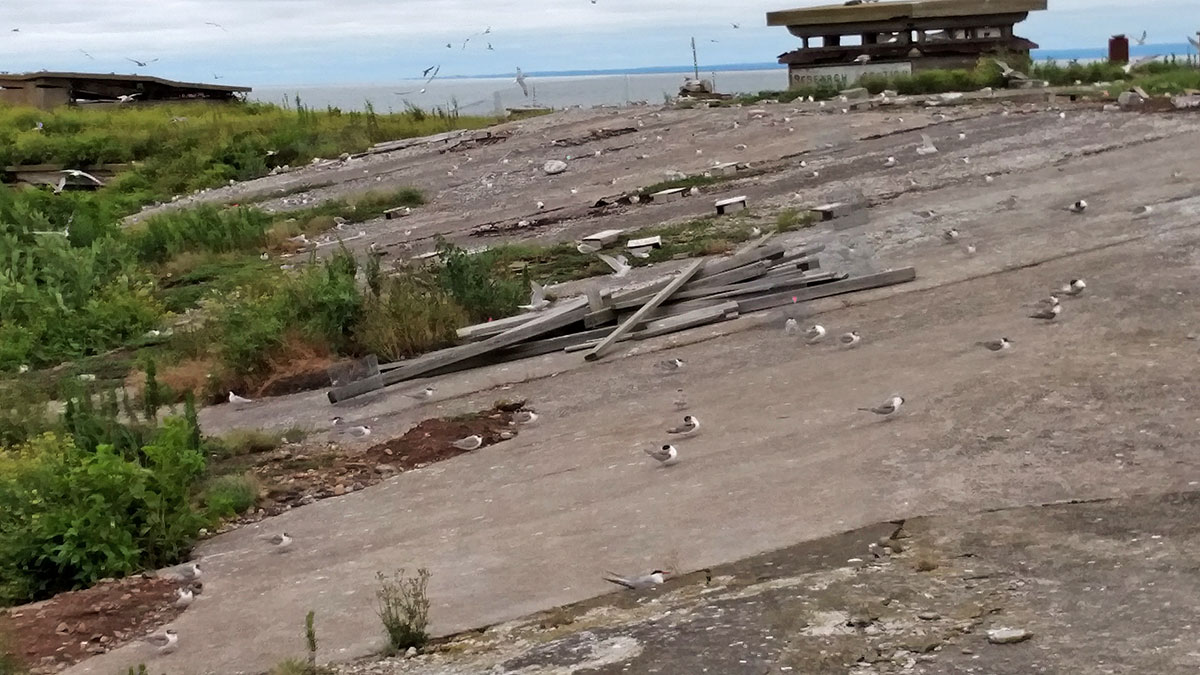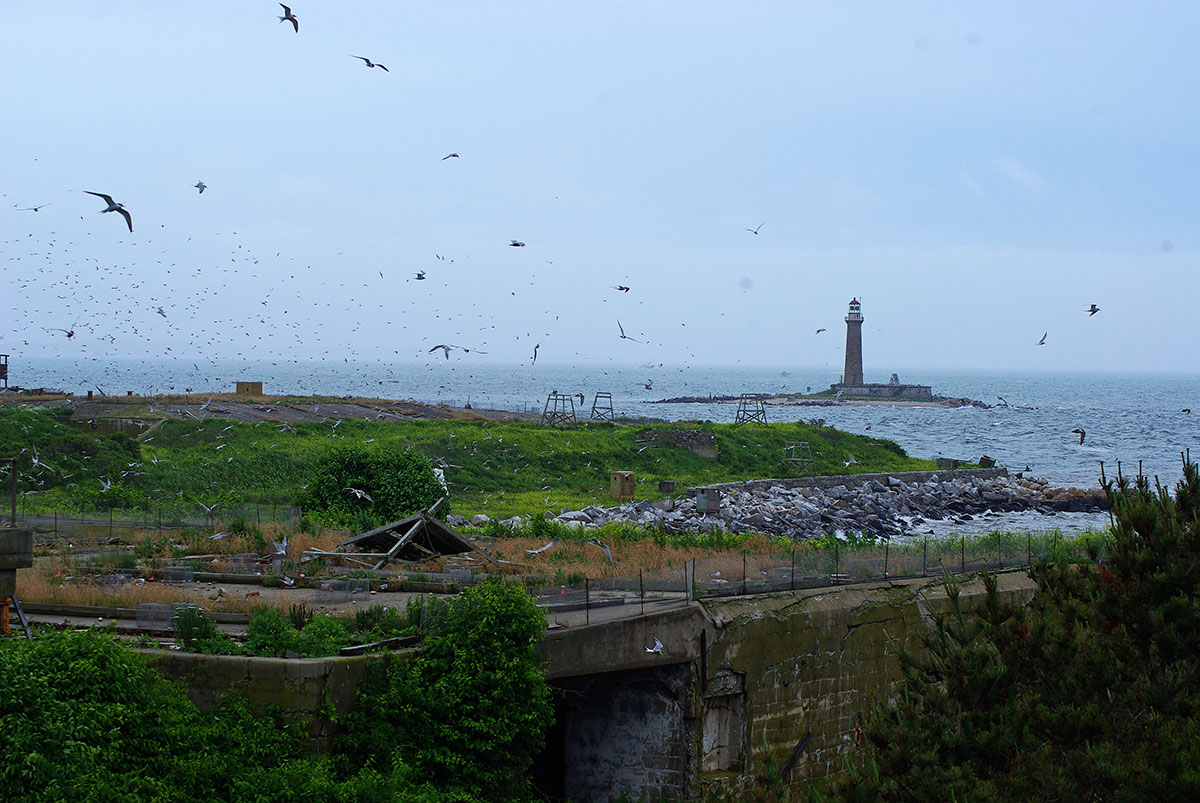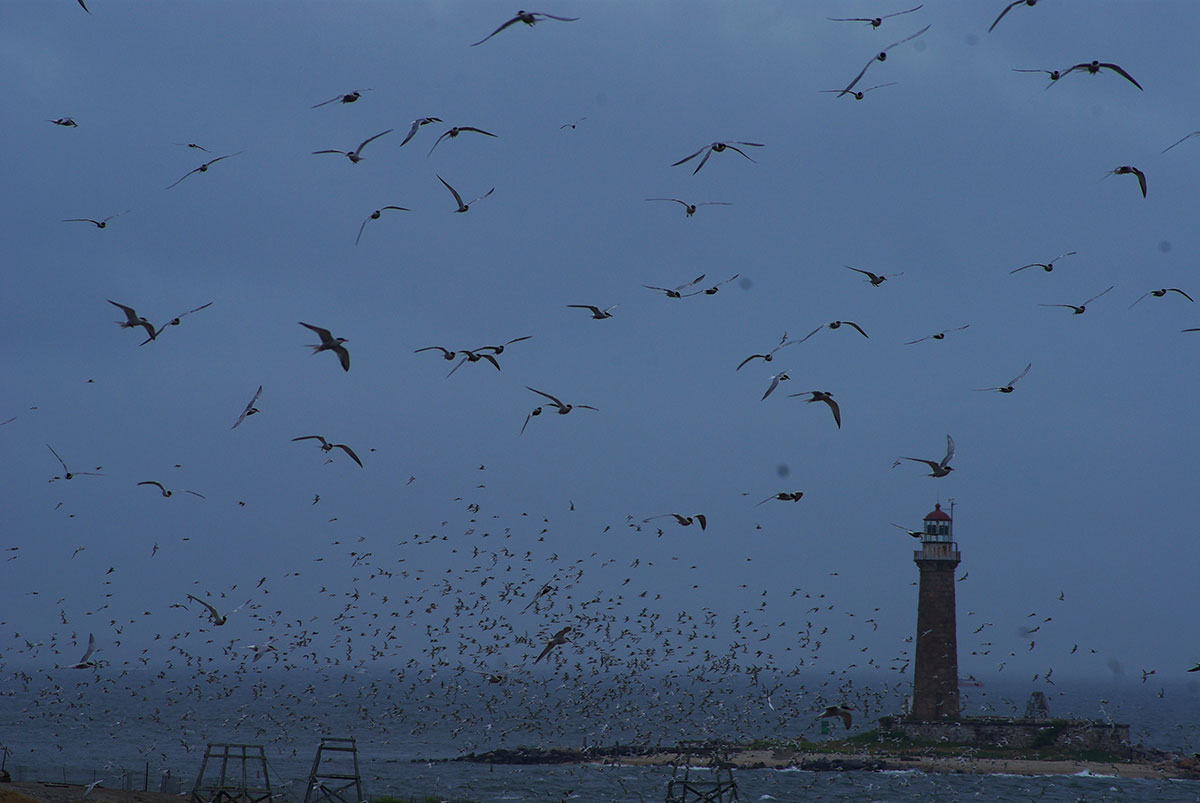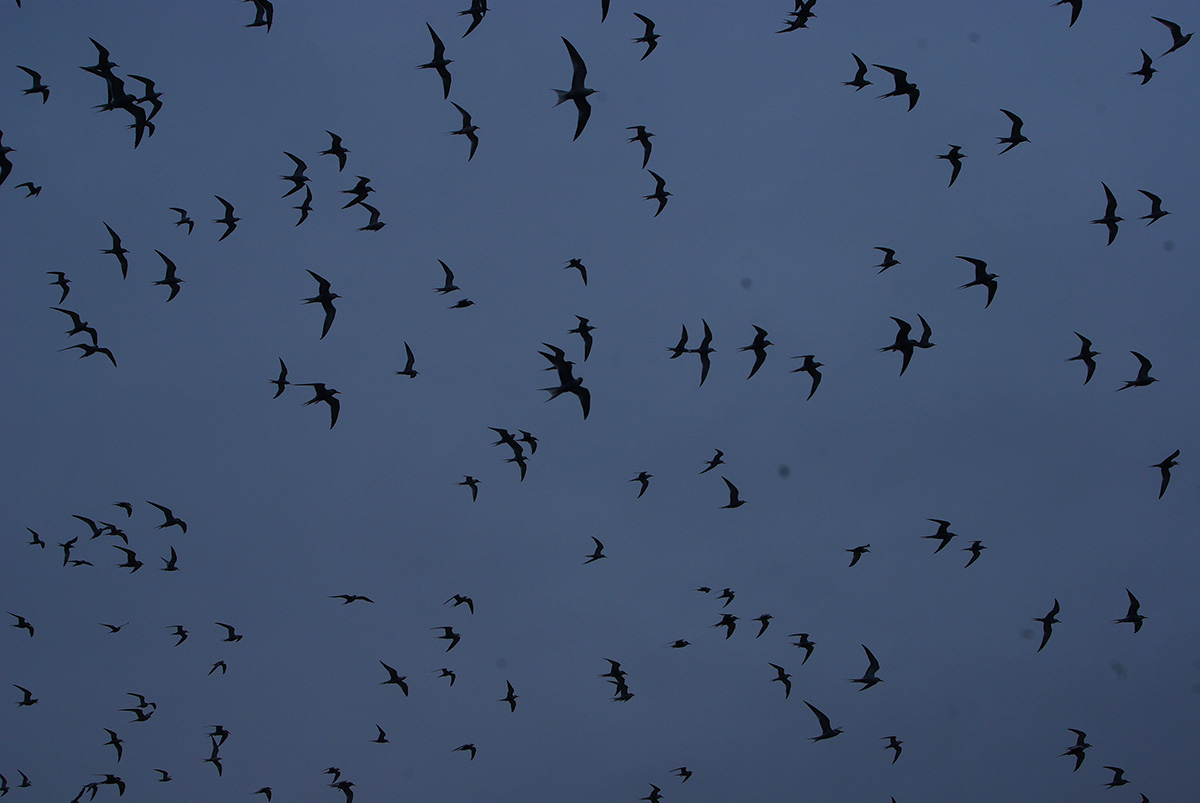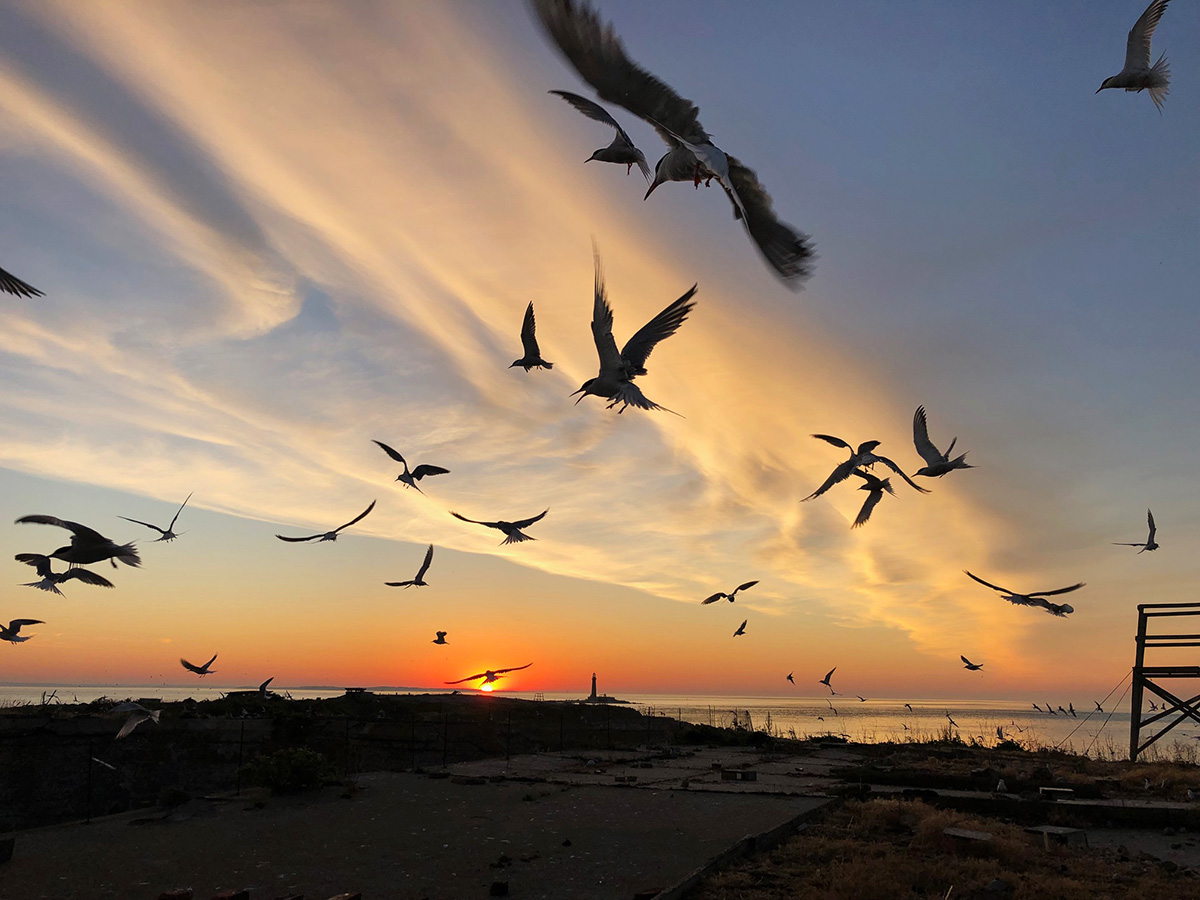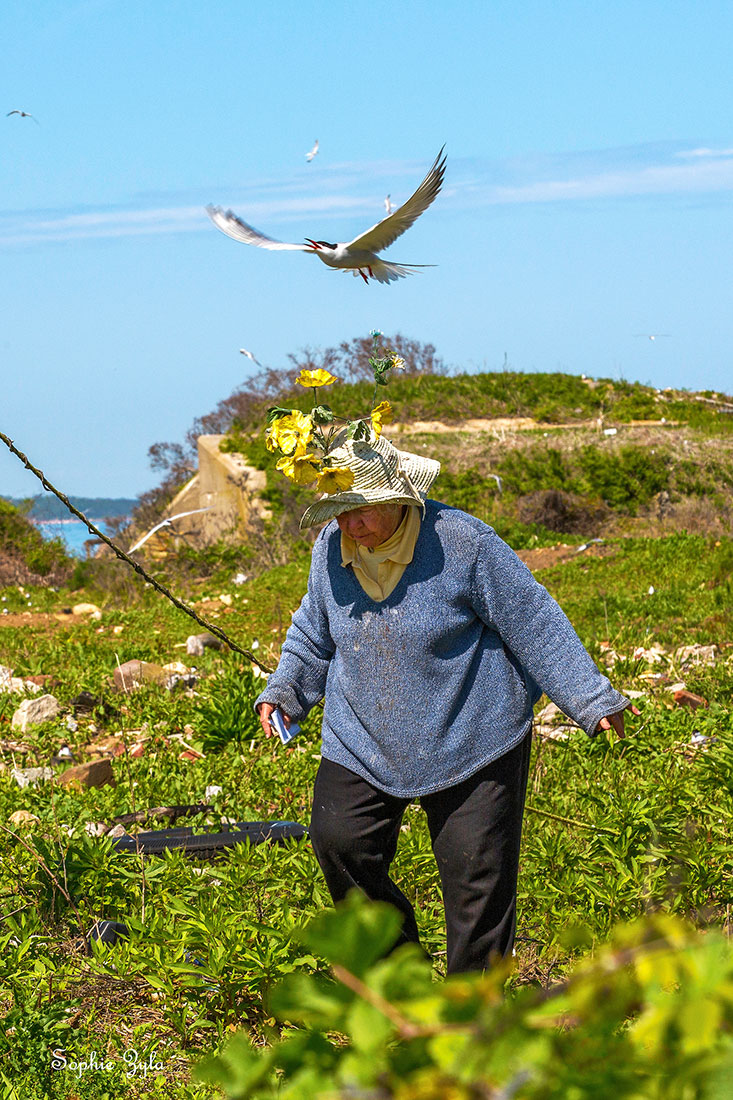ANNUAL EXHIBITION 2020
Fort Michie, Great Gull Island, N.Y.
In 1803, Great Gull and Little Gull islands were purchased by the U.S. Government from a private owner for the purpose of establishing a lighthouse on Little Gull. For almost all of the 19th century, Great Gull and neighboring Plum Island hosted thriving tern colonies. An 1896 study revealed 7,000 pairs of nesting terns on Great Gull. The U.S. Army took possession of Great Gull and began building coastal fortifications in 1897. As construction and human activity escalated, the terns were forced to abandon the island. In 1949, the U.S. Government awarded Great Gull Island to the American Museum of Natural History to make it a bird sanctuary, principally in connection with the protection and propagation of terns. . .
- Map showing location of Great Gull, Island, N.Y. between Orient Point / Plum Island and Fishers Island, N.Y. Map courtesy of UConn CLEAR Project.
- Detail from British Naval Chart, 1813. In 1803, Great Gull and Little Gull islands were purchased by the U.S. Government from a private owner for the purpose of establishing a lighthouse on Little Gull. With Little Gull Light completed in 1805, adjacent Great Gull Island was repurposed as a provisioning “plantation” for the Light’s keeper. Although small, the Island was described as suitable for raising garden crops and corn, and “pasturage for a cow or two.” Chart courtesy of Heritage Charts.
- Roseate Tern (Sterna dougallii) hand-colored lithograph by Rex Brasher from “Birds and Trees of North America,” (1931). For almost all of the 19th century, Great Gull and neighboring Plum Island hosted thriving tern colonies. An 1896 study revealed 7,000 pairs of nesting terns on Great Gull. Their island colony, already plagued by “eggers,” plume hunters, and sportsmen, came to a disastrous end in 1897.
- Two battery defense guns (six-pounders) near Battery North, later site of Battery Davis, Fort Michie, Great Gull Island, circa 1902. With tensions rising with Spain, the U.S. Army took possession of Great Gull and began building coastal fortifications in 1897. As construction and human activity escalated, the terns were forced to abandon the island. Photo source: National Archives and Records Administration (NARA).
- “Fort Michie, DI, Great Gull Island, N.Y.,” edition of Aug, 26, 1914, with later revisions. This map shows the extent that buildings, barracks and gun batteries filled the Island, especially the western section. After 1921, Battery J.M.K. Davis dominated the landscape of the east end. It held the most powerful weapon then in the U.S. military’s arsenal, the 16-inch gun. Map source: NARA, courtesy of Coast Defense Study Group (CDSG).
- 16” Rifle, Fort Michie, N.Y. This gun, 69 feet long, was mounted on a disappearing carriage that allowed it to rotate 360 degrees. It was powerful enough to fire projectiles weighing over a ton at targets more than 20 miles distant. Photo by Adelard T. LeGere, courtesy of H.L. Ferguson Museum Collection.
- 16-inch gun firing, Battery J.M.K. Davis, Fort Michie, October 1941. This photograph was kindly provided by the late Clayton E Lathrop who served as an artillery technician responsible for the 16-inch gun at Fort Michie during 1941-42.
- Aerial of Fort Michie, Great Gull Island, N.Y., date unknown. In September 1948, three years after the end of World War II, the War Assets Administration declared Fort Michie a surplus asset, generating a flurry of offers to buy the island property. Photo source: NARA, courtesy of Mark Berhow, CDSG.
- High angle view of Fort Michie, Great Gull Island, date unknown. Potential buyer’s proposed uses for Great Gull included a cancer research laboratory, a potato farm, a bird sanctuary, and a private family retreat. A dozen bids were initially submitted and two were pulled for consideration: the cancer laboratory and a proposal from the American Museum of Natural History to make Great Gull a bird sanctuary, principally in connection with the protection and propagation of terns. On April 1, 1949, the U.S. Government announced that Great Gull Island had been awarded to the American Museum of Natural History at no cost. Photo courtesy of H.L. Ferguson Museum Collection.
- AMNH staff aboard a boat approaching Great Gull Island, circa 1949-1951. After the purchase, Museum staff and interested supporters visited the Island at least once in 1949, with follow up inspection trips over the next few years. Photo courtesy of the Great Gull Island Project Archive at the American Museum of Natural History (AMNH).
- AMNH staff exploring Great Gull Island, circa 1950. This group is on the west end of Great Gull looking east to the cluster of buildings at the middle of the Island and the gun emplacements of Battery Palmer. A searchlight house stands alone at right. Photo courtesy of the Great Gull Island Project Archive at the AMNH.
- Inspection trip to Great Gull, circa 1950. This closer view of surplus structures at Fort Michie includes the fire control tower of Battery Palmer’s two 12-inch guns at right (today used as living quarters), two non com officers quarters at center (today used as dorms), along with several buildings that no longer stand. Photo courtesy of the Great Gull Island Project Archive at the AMNH.
- Inspection trip to Great Gull Island, circa 1950. The groups from and associated with AMNH who visited Great Gull in the early 1950s were focused on how to prepare all sections of the Island to encourage the return of a nesting tern colony. The Museum assigned the Linnaean Society of New York, a group comprised of dedicated amateur birders, naturalists and ornithologists, the primary responsibility for this important work. Selected Fort Michie buildings were razed, vegetation cut or burned, and detritus cleared to increase and improve potential nesting areas. Photo courtesy of the Great Gull Island Project Archive at the AMNH.
- In 1951, two adventurous and dedicated staff of the AMNH, Lois J. Hussey and Catherine M. Pessino, spent 28 days living on Great Gull to check for evidence of nesting terns, determine frequency of unauthorized trespassers, and to help plot the future course of the island as a tern colony site. They lived in the four-story observation tower pictured here. While on Island they counted bird species (37), collected plants and insects, but found no evidence of nesting terns. After they departed, Great Gull was left uninhabited. Photos from Natural History, April 1951, courtesy of the Great Gull Island Project Archive at the AMNH.
- Terns and tern chicks on Great Gull Island, date unknown. A Linnaean Society member flying over Great Gull in 1955 was the first to spot that nesting terns had returned to Great Gull Island. The initial count was 25 pairs of Common Terns, followed later by Roseate Terns. Those numbers have grown exponentially since the first days of the rebirth of the colony. Photos courtesy of the Great Gull Island Project Archive at the AMNH.
- Catherine M. Pessino and Lois J. Hussey atop an emplacement at Great Gull Island, date unknown. In 1963, Catherine Pessino, a dynamic force in AMNH’s Education Dept., invited Helen Hays, who was then cataloguing birds at AMNH, to accompany her on a trip to Great Gull. That invitation changed the course of Great Gull’s history. At the time, there were approximately 1,500 pairs of Common and Roseate Terns nesting at Great Gull. Helen was immediately taken by the possibilities of ongoing research on site at Great Gull. No one could have guessed that Helen would make that research the focus of her life’s work. Photo courtesy of the Great Gull Island Project Archive at the AMNH.
- News photo of Helen Hays from article describing her disturbing discoveries about PCB levels in the food chain of Long Island Sound. From the time of Helen’s first visits to Great Gull in the 1960s to today, Helen has been an indefatigable advocate for and caretaker of the nesting tern colony on Great Gull. She became the director of the Great Gull Island Project in 1969 and remains so today. The Project under her stewardship sounded warnings in the early 1970s about the dire threat posed by PCBs after escalating numbers of chick deformities were discovered in the Great Gull tern colony. Photo: Daily News, March 21, 1972.
- Albert Gordon and Helen Hays, Great Gull Island, circa early 1980s. Mr. Gordon, a Fishers Island seasonal resident, was quite interested in the Great Gull Island Project and was a supporter. Photo courtesy of the Gordon family.
- Helen Hays watching the terns as they first arrive for the season, May 3, 2014. The Great Gull Island Project, succinctly defined as “a monitoring study of Common and Roseate Terns nesting on Great Gull Island,” is a complex cooperative effort that unites dozens of dedicated volunteers each year in a mission to sustain, research and expand the Island’s nesting tern colony. Photo by Matthew Male.
- Terns at the west end of Great Gull in front of blind, July 8, 2018. “The former site of an army fort, its overgrown battlements are now defended by the largest concentration of nesting Common Terns in the world (9,500 pairs). The boulders dumped around the edge of the island to stabilize the shoreline, as well as some of the retaining walls of the fort, offer nesting sites for 1,300 pairs of Roseate Terns, the largest nesting concentration of this endangered species in the Western Hemisphere.” Quote from “Great Gull Island Project.” greatgullisland.org. Photo by Matthew Male.
- Helen Hays recording part of the year on the wall of Headquarters, aka the Carpenter Shop, May 5, 2015. The tradition is that the first of the crew to arrive at Great Gull for the season makes the first number mark. The last three numbers are filled in by other crew as they arrive. Helen has worked at Great Gull for approximately six months out of every year since 1969. This year because of COVID-19, the on site work is on hold and she has not been able to go. Photo by Matthew Male.
- Joan Walsh of Massachusetts Audubon and Helen Hays observing birds from the Dockhouse Seawatching Blind, May 3, 2018. They are counting birds, noting what fish they are eating, and recording the band numbers of birds sitting on the dock railing. The band numbers help researchers in numerous ways, including tracking migratory patterns and bird longevity. The bands also enable ornithologists to trace tern lineage back multiple generations. Photo by Matthew Male.
- Helen Hays dissecting two terns to determine if they had died of starvation due to shortage of fish that year, June 8. 2014. Photo by Sophie Zyla.
- Helen Hays teaching an intern how to band, measure and mark down data, July 16, 2017. Each year Helen, with the help of Matthew Male, recruits college ornithology and biology students for summer field work. Helen and her team train new recruits how to trap, band and record data on both tern adults and chicks. Photo by Matthew Male.
- Volunteers taking new nesting boxes to shoreline sites for Roseate Terns, June 11, 2014. The volunteers stay on Great Gull for varying lengths of time, anywhere from day trips, to long weekends, to multiple month stays. Their numbers range as well, but average perhaps 15 to 20 on Island from the end of May through June during the peak hatching season. The numbers then drop off considerably with the final crew leaving the Island historically on Labor Day, but recently later in September. Photo by Sophie Zyla.
- Roseate Tern nesting terraces and nesting boxes, April 19, 2015. These terraces, built near the shoreline, help increase the available nesting areas for Roseate Terns. The bricks and rocks serve as dividers and their weight keeps the cubby holes in place. The nests are out of sight in the cubby holes. Photo by Robert Lorenz.
- Around 6 a.m. each morning and 6 p.m. each evening, volunteers head out to trap adult terns so that they can be banded, weighed, measured, and released. Photo by Matthew Male, July 8, 2018.
- Group checking Common Tern nests, June 7, 2018. Volunteers monitor and assess the number of nesting pairs, hatching success, nesting productivity, cause of egg loss, competition for nest sites, competition with predators, nest site fidelity, type of prey, and number of times chicks are fed. Photo by Susan Tamulevich.
- Tern dive bombing Helen Hays, 2015. Experience has taught those working on Great Gull that hats with artificial flowers sewn on top help stave off serious head lacerations. The terns pull up from their dives after hitting the tops of the flowers. Prior to the flowered hats, some volunteers used hard hats which damaged the terns’ bills. Photo by Sophie Zyla.
- Research crew checking endangered Roseate Tern nests, July 11, 2017. Photo by Matthew Male.
- Roseate Tern nest data gathering continues along the rock line, July 11, 2017. Photo by Matthew Male.
- Nest checkers take a deep dive into the rocks, 2015. When Fort Michie was still active, excavated broken stones from subway construction in New York City were dumped along the shoreline to buttress it from erosion. Almost a century later, this rip-rap provides good nesting areas for Roseate Terns who prefer rocky shoreline locations. Photo by Sophie Zyla.
- Marking nest sites with fiberglass dowels in the high vegetation, June 15, 2011. Photo by Sarah Nystrom, U.S. Fish and Wildlife Service (USFWS).
- Tern nest with marked tongue depressors, 2015. The nests all receive a number as do the eggs which are numbered in the order in which they arrive. This allows the Project to track losses within a given nest to natural causes and predators. Photo by Sophie Zyla.
- Nest checkers on Great Gull using GPS units, date unknown. In recent years, nest locations have been logged by GPS. Photo by Matthew Male.
- Colorful bird banding bags drying outside Headquarters before being shipped off island for cleaning, 2015. Each bag has a name, and that name along with nest number are given to the person recording the bird data into the log. Photo by Sophie Zyla.
- Left: Grace Cormons banding a Roseate Tern, June 20, 2014. Grace is the leader of the roseate research team and has been focused on Roseate Terns on Great Gull since the mid-1960s with some time off to raise a family. Photo By Sophie Zyla. Right: Argentinian volunteer Patricia Montejo measuring and weighing a tern back at Headquarters, June 15, 2014. Photo by Sophie Zyla.
- Joe DiCostanzo teaching a volunteer how to band, August 14, 2016. The data collected in the field are compiled and then entered into a database by Joe DiCostanzo at Headquarters on Great Gull and at the AMNH during the winter months. Photo by Melinda Billings.
- ”Little Argentina,” west end, Great Gull, with new blind on its side in background, March 26, 2015. Because the success of the tern colony on Great Gull is dependent on the success of the colonies at their wintering grounds in South America—and vice versa—it seems inevitable that like-minded people at both locations would find each other, and they did in 1995. Since that time, collaborative projects have evolved with Argentinian ornithologists and the Great Gull Island Project sharing data. In recent years Argentinian volunteers have arrived at Great Gull each season and taken on a great deal of the banding work, primarily at the west end. That section of the Island has been named in recognition of their contribution. Photo by Sophie Zyla.
- Some unexpected Common Tern visitors at GGI Headquarters, May 24, 2015. Photo by Sophie Zyla.
- Headquarters, the center of the human universe on Great Gull, July 16, 2017. The building at center holds the kitchen, the banding room, the banding lab, the carpentry shop, the office and the pantry. There is no electricity, but the office computers are powered by a small gasoline generator that also charges LED lights and florescent lights used in the laboratory, and scales used in the bird weighing process.. The Carpenter Shop is wired to run by generator and a larger mobile gas-powered generator is used for power tools and equipment in the field. There is also one solar panel that keeps a 12-volt battery charged. Photo by Matthew Male.
- Inside HQ, a volunteer is preparing his bag for use in nest checks and chick banding out in the tern colony, June 7, 2018. Adults are banded at HQ; chicks are banded in the field. These “bags” (carpenter’s aprons) might hold as many as one hundred tongue depressors to mark nests, along with a GPS unit, a notebook, banding pliers, Magic Marker and pen. Photo by Susan Tamulevich.
- The kitchen and dining room, September 12, 2014. Everyone helps with food preparation at Great Gull while also sharing kitchen chores. Food is brought in weekly by boat, often after being dropped off at a dock in Noank, Conn., by Peapod. The lighting at dinner is by candlelight. The stove, refrigerator and grill use propane. Photo by Matthew Male.
- Laundry Day, September 10, 2019. As there is no running water on Great Gull, these clothes were washed with rainwater collected from Battery Palmer’s 12-inch gun emplacement. Water for drinking and cooking is brought in by boat. Photo by Matthew Male.
- Sarah Nystrom, USFWS, on left, posing with Great Gull volunteers and interns, June 15, 2011. The tower that housed Catherine Pessino and Lois Hussey during their trip to Great Gull in 1951 can be seen in background. Photo by USFWS.
- Two Dorms, April 15, 2019. The success of tern habitat management in the 1970s and 1980s led to increased nesting, which in turn increased the need for more students and volunteers. Two non com officers quarters were renovated in the mid-to-late 1980s, creating much needed housing for 20 people. Photo by Matthew Male.
- A recently completed dock at Great Gull was destroyed by Superstorm Sandy in 2012. Numerous individuals, groups, and institutions contributed funds for a new dock. A grant from FEMA was critical to the success of the dock campaign. Note the remnants of the original Fort dock at left. Photo by Robert Lorenz.
- The remnants of the 240-foot long Government dock (1919) at Fort Michie. These plaintive pilings are a testament to the destructive and erosive power of storms over time. Photo by Susan Tamulevich, June 7, 2018.
- A CH-47 Chinook helicopter carrying a load of lumber and supplies as it approaches Great Gull Island, April 25, 2014. 40,000 pounds of cargo were delivered from Groton, Conn., in three trips by the Connecticut National Guard. U.S. Army Photo by Staff Sgt. Jordan Werme.
- Helen Hays overseeing the rebuilding of bird blinds and observation posts destroyed by Superstorm Sandy utilizing lumber delivered by the Connecticut National Guard. U.S. Army Photo by Staff Sgt. Jordan Werme, May 2, 2014.
- Matthew Male building floor of Dockhouse Seawatching Blind, April 27, 2015. With the intensity of storms increasing, the maintenance and construction of new blinds, nesting terraces, and building infrastructure is always a high priority. These construction projects are often handled by Matthew Male who first got involved with the Great Gull project in the 1970s. There is a also a dedicated crew that arrives early on Great Gull that prepares and repairs the Island’s infrastructure before the arrival of those looking after the tern colony itself. Photo by Bob Kane.
- The new dock at Great Gull was completed in October 2015. Photo by Matthew Male, March 3, 2016.
- The new dock is appreciated by all residents of Great Gull, May 2, 2017. Photo by Matthew Male.
- The completed Dockhouse Seawatching Blind, April 27, 2017. This blind was completed on Earth Day, 2017. Photo by Matthew Male.
- A Snowy Owl taking in the sights offered by the Dockhouse Blind’s roof. April 23, 2018. Photo by Matthew Male.
- The rebuilt “Habitat” blind, Great Gull Island. The control house at Battery Benjamin was turned into an observation blind in the early days of the tern project and named “Habitat.” When it was rebuilt in 2018, nesting substrate was brought up to cover the concrete so birds would nest and observers could watch them at eye level. Photo by Matthew Male.
- An inside view of the rebuilt Battery Benjamin “Habitat” blind, June 8, 2019. Photo by Matthew Male.
- The photographer’s iPhone 8 captured this remarkable view from the “Habitat” blind, June 8, 2019. Photo by Matthew Male.
- A Common Tern chick as seen from the eye-level “Habitat” blind, July 8, 2019. Photo by Matthew Male.
- An emplacement overrun by vegetation, June 17, 2011. One of the biggest threats to the tern colony on Great Gull is unchecked growth of invasive plants that blanket areas once used by nesting terns. Ecologist Juliana Barrett has noted a number of control tactics that have failed: “They’ve tried burning, flooding areas with seawater, shoveling, bulldozing, and plowing, all in an effort to clear vegetation…” (Quote from Juliana Barrett’s “For the Birds-Great Gull Island” Wrack Lines 100, 2015.) Photo by Sarah Nystrom, USFWS.
- A wider view of ruins, old and new blinds, and invasive growth at western tip of Great Gull. Connecticut Sea Grant, UConn CLEAR, USFWS, and AMNH are all partnering to try to solve the long-standing problem of unchecked invasive spread and to create an overall land management plan for Great Gull. Photo by Sarah Nystrom, USFWS.
- The eastern tip of the Island is dominated by former Battery J.M.K. Davis, the giant emplacement that once held the 16-inch gun. Photo by Joel Stocker, UConn CLEAR, September 11, 2010.
- Former Battery Davis, Great Gull, April 29, 2015. This view of Battery Davis with Bob Kane standing in background reveals the scale of this mammoth emplacement. Photo by Matthew Male.
- Terns facing into the wind on the side of Battery Davis, Great Gull, July 25, 2017. It’s one of the most delightful ironies of the Great Gull story that thousands of terns now have effective control of the site that once housed America’s most powerful weapon. Great Gull is once again their territory. Photo by Matthew Male.
- Looking east at Little Gull Light, June 17, 2011. As darkness falls on Great Gull, terns can be seen in great numbers, visual testimony of the success of the tern restoration project launched more than 50 years ago. Photo by Sarah Nystrom, USFWS.
- Terns flying at night near Little Gull Light. Photo by Sarah Nystrom, USFWS.
- Terns silhouetted against the night sky, Great Gull Island. Photo by Sarah Nystrom, USFWS.
- Terns silhouetted against the sky at sunrise, June 8, 2019. Photo by Matthew Male.
- Three cheers for Helen Hays and all she has done and is continuing to do for the nesting inhabitants of Great Gull Island. Hats off to the staff of the AMNH, members of the the Linnaean Society, and the countless, dedicated volunteers who have made and continue to make the Great Gull Island Project the success that it is, and certainly will continue to be if the future is met with the same collaborative sprit that has characterized its past. Photo by Sophie Zyla.
Video
Gull Island, N.Y.
Photographed June 1949 by John W. MacKay for The American Museum of Natural History
To learn more about the monitoring study of Common and Roseate Terns nesting on Great Gull Island, please visit:
greatgullisland.org
For more information on biodiversity and conservation efforts by the American Museum of Natural History, please visit:
amnh.org
Annual exhibition sponsored by:
ACKNOWLEDGMENTS
Fort Michie, Great Gull Island, N.Y.
The history of Fort Michie was in hand when this project began, but the HLFM files had almost nothing on the details of life on Great Gull Island after the military departed in the late 1940s. After Helen Hays, director of the Great Gull Island Project, provided an introduction, Dale Dancis, who is chronicling the history of the Great Gull Island Project, shared remarkable images from the Great Gull Island Project Archive at the American Museum of Natural History that dated primarily to the late 1940s and 1950s. She also sent in information on how the Project first got started. Matthew Male’s extraordinary photographs of terns taken on Great Gull were familiar to me, but I had no idea that he had been working there since the mid-1970s and had photos on a multitude of subjects. Once he agreed to help, I peppered his in-box with dozens of requests for information and images that he responded to without a hint of complaint. Because Matthew is often on Great Gull early and late in the season and not there during peak season when the volunteers occupy the Island, I turned to a second photographer that Dale recommended, Sophie Zyla. She had wonderful images of the volunteers at work and daily life at Great Gull during the tern nesting season. In summary, the mixture of fabulous photographs and extensive in-house knowledge provided by the trio of Dale, Matthew and Sophie formed the complementary “glue” that kept the Great Gull section of the exhibition stuck together.
But there were also other a number of other photographers whose work helped make the Great Gull story come alive, especially Susan Tamulevich, the director of the Custom House Maritime Museum in New London, who photographed both her visiting groups and volunteers working at Great Gull; Robert Lorenz, who, while primarily known for his documentation of Plum Island, had a very productive photo shoot on Great Gull; Sarah Nystrom, U.S. Fish and Wildlife Service, who in a short stay on Great Gull generated a powerful set of images on a variety of subjects; Joel Stocker, UConn CLEAR Project, whose aerial of Battery Davis is breathtaking; Melinda Billings who photographed a key member of the Project, Joe DiConstanzo, at work; Staff Sgt. Jordan Werme, 130th Public Affairs Division, Connecticut Army National Guard, who chronicled the delivery of lumber and supplies to Great Gull by helicopter; and Mark Berhow, CDSG, who documented the state of gun emplacements and military structures as he visited each site with members of his organization. Finally, the Gordon family kindly allowed us to display a photo of the late Albert Gordon posing with Helen Hays on Great Gull. Mr. Gordon was a strong supporter of both the Great Gull Island Project and the HLFM, another tie between neighboring islands.
The following institutions provided images included in the exhibition: American Museum of Natural History, Coast Defense Study Group, Daily News, Great Gull Island Project Archive at the American Museum of Natural History, Heritage Charts, National Archives and Records Administration, and UConn CLEAR Project.
The short movie accessible below this exhibition, “Gull Island, N.Y.,” photographed June 1949 by John W. MacKay for The American Museum of Natural History, is courtesy of the AMNH. It reveals the world of Great Gull Island at the very start of the project to restore nesting terns to their former colony site.
We thank each and every one who helped on this section (including those I may have forgotten to mention). We couldn’t have done it without you!
Pierce Rafferty,
Director,
Henry L. Ferguson Museum

